
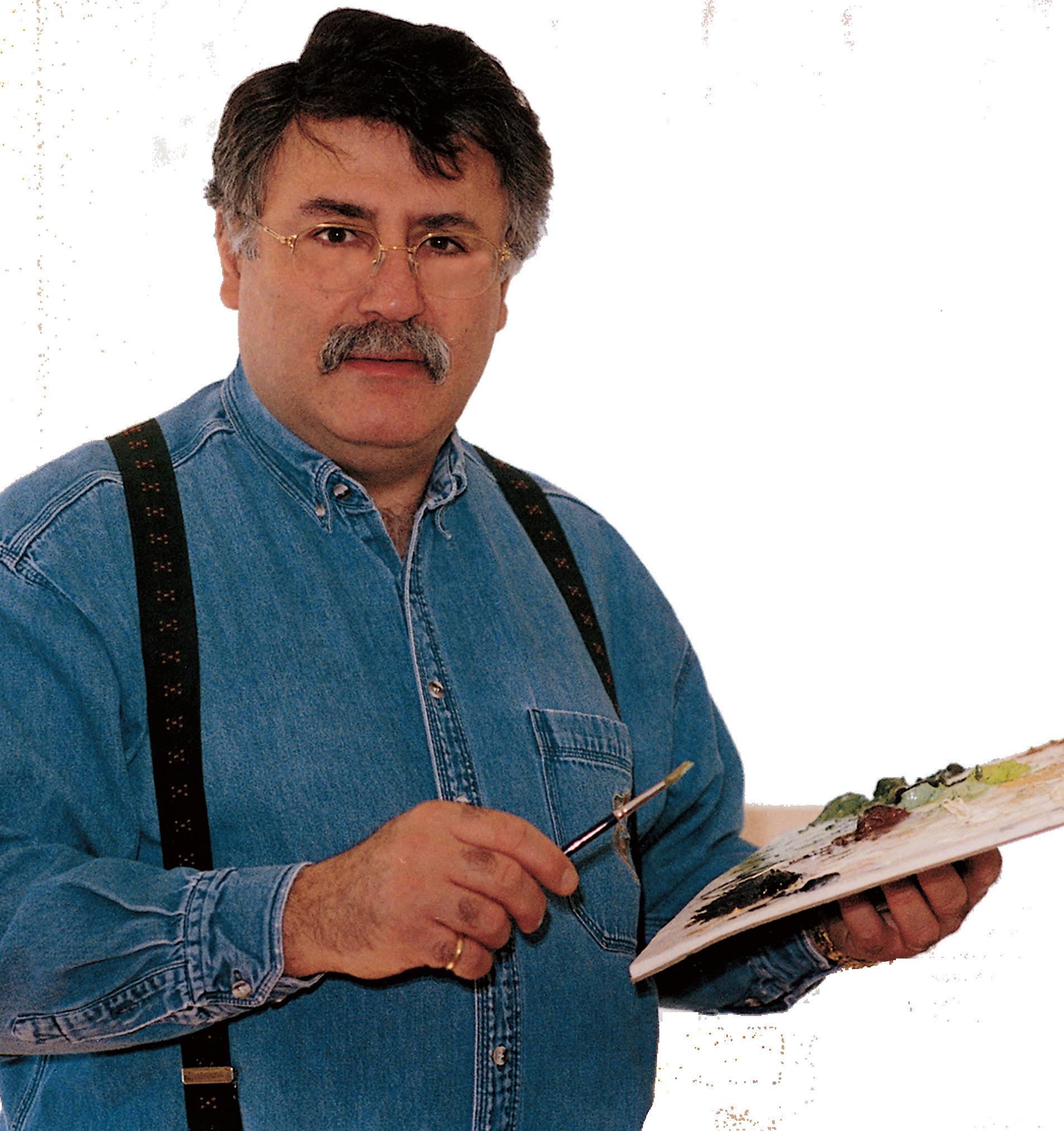
SPECIAL RETROSPECTIVE EDITION IN PRINT & ONLINE
Samir Sammoun is a world-renowned Post-Impressionist painter. From the lush, lavender fields of Provence to rich, autumnal landscapes and quaint city streets bustling with humanity, Sammoun’s brilliance is unparalleled in capturing the atmospheric and fleeting colors of our ever-changing world.
Sammoun’s innovative approach and celebrated compositions make him one of the most acclaimed landscape painters of our time. Sammoun continues to attract the attention of international scholars and art lovers. Among other honors, Sammoun was awarded the prestigious Order of Merit by the City of Brossard, an honor reserved for residents who demonstrate an exceptional commitment to the community. His work is in countless private collections and an ever expanding group of museums.
Artist Statement
by Samir Sammoun
“When I started to be attracted to paint in my childhood, my focus was how to manipulate oil paint or watercolour, both medium where enjoyable to me. I started water colouring at the age of 5, and as you know, my first experience with oil happened as I recall at the age of 13. Subject matter was at that moment romantic scenery such as sunset or seascape with a boat, etc. It was playing with colour that grabbed more my attention. As I recall I was more attracted to old masters including Turner, Corot, Fragonard and others. Impressionism started to get my attention in the early twenties, and first of them was August Renoir, then Claude Monet. And then Vincent Van Gogh captured my attention with his bright colours rendering of Provence. I guess I understand, why. I am born in Lebanon which has the same luminosity as south of France. Cypresses, wheat fields, olive groves, all these were subjects that I recall from my childhood. For me the challenge was to render the beauty of such subjects in my own way and it was obvious and a must for me to create my own class of things where a new technique should be created to characterize my art. Of course I could have done beautiful rendering of landscape and cityscape using classical impressionist technique. I mean if you look side by side to paintings by Monet, Sisley or Pissaro, they have similar technique. The difference is the mastering of the colours, hue and subject. Renoir was something else, as well as Cézanne, etc. Van Gogh was definitely different as well as the variety of subjects he treated and mastered like no one else in my eyes.
Then came the Fauves with bright colours and hues and it was a school by itself. So, from what is left or what could be the new way special to me, I create to render the beauty of nature. Here is how I see it: First it came to me after a deep observation of the nature, especially landscape of wild fields of flowers, apple orchards, olive groves, etc. When you observe carefully such landscapes, you notice that the scene is basically composed of layers of colours and hues superposed in random (means individually unorganized manner) yet the final result looks very much similar. I explain: When you stand before a wheat field in the wind, no matter what waves the wheat follows with the wind (individual random layers of colours superposed one after the other) the wheat field looks almost similar with one exception, it is vibrant and it lives. So I said to myself, if you want to paint a wheat field all you have to do is to master the layers of colours and hues with spontaneous and energetic brush strokes without any premeditation of what the individual spots of colours are but having in mind always what the general scene you try to paint should represent. This is how I paint. I know I am doing a wheat field, and the final result is a wheat field, but the individual strokes are rendered in random manner with no premeditation except not to divert from the general representation the subject is meant to be, exactly as if my mind, my hand and my brush are the wind carrying out the light on the tip of the brush and depositing it on the canvas. The canvas is first prepared with a coat of burnt sienna. That is the light that integrates all the subject matter. And this coat appears everywhere on the canvas and is one important characteristic of my technique.
Thatburnt sienna is the light that integrates the scene and gives it the desired vibration. The second important characteristic is the heavy impasto I deposit on the canvas which makes possible the random rendering of the subject. The third being the vibration of the layers of colours when they are one beside the others to create the atmosphere, the ambiance and the temperature of the moment. The fourth is the mix of a number of colours in the same brush stroke which give the flickering effect. The fifth being the loose movement I give to each stroke as if the wind is playing with it which gives the painting the movement effect, etc. When I paint, I am always standing up. It is a very energetic process where I deposit cluster of paintings of the same hues and go back to see how it vibrates and integrates with rest. I feel in my mind that I am doing a right thing when I am painting and that the result will look to my satisfaction from the right distance. Because seen from close my art looks abstract. The painting looks in its three dimensions from the right distance. The paintings start building up with thick layer after layer of paints rendered in an automatic manner until the final light spots are deposited. No two paintings of the same subject can be the same and I am incapable of creating the same painting I already did. And, of course, no one can copy a Sammoun. People and art critics say that my art is very exclusive, vibrant and lives to talk to you depending on daylight, the distance and the angle you are looking to it.
“A Man For All Seasons”
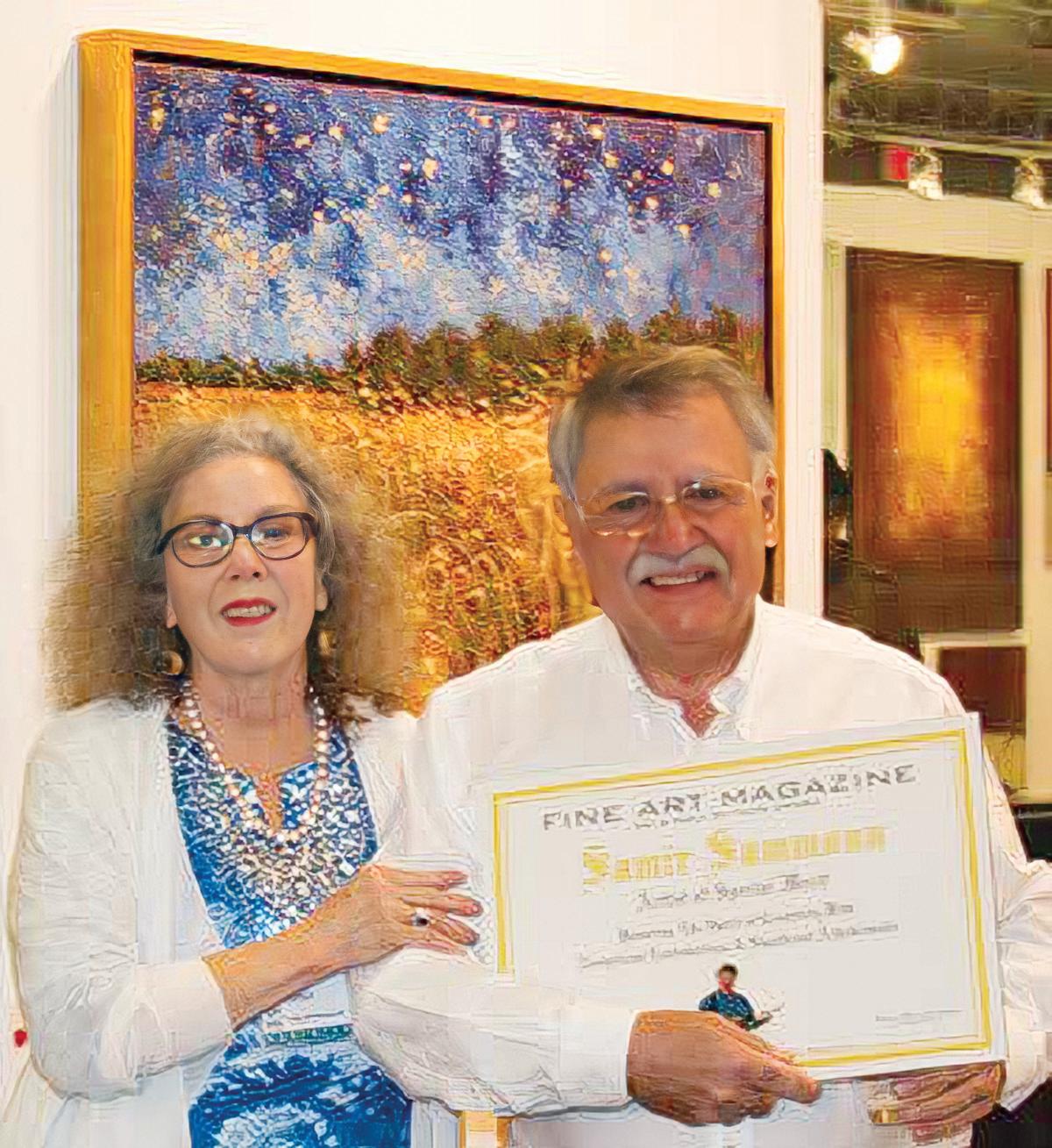

“Sammoun’s body of work is an in-depth depiction of the connections he makes between his long-time residence in Montréal and birth and childhood in Lebanon. Painting and sculpture emerge as statements of common familiarity to be shared by all. His admirers enter into a personal involvement with the work making him a man for all seasons of expression through the universal language of art,” stated Jamie Ellin Forbes, Director of the Fine Art Museum of Long Island (1990-1995) and publisher of Fine Art Magazine in bestowing the magazine’s “Artist of Special Merit” award to Samir at Artexpo in 2016. “Honoring the spirit of creativity with exceptional contributions and significant achievement, Sammoun has taken his role as an artist to an exceptionally high level, not only for his paintings but for his interests in the human condition and what he can do to foster a more peaceflu environment for all.
Samir Sammoun’s originality and unique style have caught the attention of viewers, collectors and art lovers worldwide. When he first showed his work at ArtExpo in New York in 1996, the reaction was immediate and positive. What was said about him then still holds true today: “The fresh colorful impressionistic renditions presented in his artwork have been received with unprecedented enthusiasm... Samir is a fresh and exciting talent depicting the landscapes he sees in rich colors with his own wonderfully unique impressionistic style.” Robert L. Mooney, Director of the Galleries J.R. Mooney, San Antonio, Texas. for further information and images visit www.samirsammoun.com

Page 16
• SunStorm/Fine Art • Spring 2017
SunStorm/Fine Art Magazine publisher Jamie Ellin Forbes bestowed the publications’ “Artist of Special Merit” award to Sammoun at Artexpo 2016
Lavender Bekaa Valley, 12x16,
Samir Sammoun at his exhibition reception at the Montréal Musee des Beaux Artes, with Victor Forbes (center back row), Gaetano DiTrapani C.E.O. at Group PDI Inc. of the stellar Montréal printing company (holding Fine Art Magazine) and Johnesco Rodriguez of Art Monaco.
Born in the verdant hills of Lebanon, at roughly the trining point between the Garden of Eden and the Promised Land, the Sprit of the Divine informs every brush stroke in the art of Samir Sammoun so that each flower and blade of wheat, each hazy mountainside, apple orchard, olive grove and droplet of snow in renditions of the city resonate with reverence in a palette of non-sectarian holy beauty. The powerful elements of nature are so entrenched in the artist’s soul that mere flat surface cannot contain his joy and respect. Paintings are built up with dimensionality, as in the language of Braille, so that the message is not only be seen, but felt. There are those who would categorize Sammoun as an Impresionist, or a landscapist or even put him in with the wildness of the Fauves, but to one who knows, the paintings of Samir Sammoun are primeval paens to the delicate beauty of nature created in controlled bursts of painterly passion, not to be classified with any particular school. Indeed, to be amidst a collection of Samir Sammoun works of art is to be transported to a far-away forest where light and shadows interplaying with trees and leaves on the ground are so naturally illumined that one cannot turn down the invitation therein for a virtual walk into the mystical depictions of his particular reality.
Without fanfare, but with great dramatic effect all the more memorable for its subtlety, Sammoun magically sets himself apart from every other painter seeking to represent nature through his or her singular impressions. In his delicacy, there is a power. A sole flower, one among many in a sun-drenched pasture, is as memorable for a singular droplet of the most brilliant red as it is for its membership in the entirety of the composition. Sammoun handles the fate of his creations as if the individual images were characters in a novel, or a lengthy poem. Like a flower, these paintings bloom, but unlike a flower, they do not fade away. In these works, there is ample opportunity not only for a casual viewer to enjoy a happy natural scene, but for one to take a deeper look into serious matters of the human condition, and the state of our home planet, as reflected through the aforementioned subject matter. As a gaze into the nocturnal heavens becomes “Starry Night,” for his soul mate van Gogh, to Sammoun, a collection of flowers or stalks of wheat, from his unique perspective, becomes a “Field of Faith.” His faithful renditions of the ancient gnarled trunks of the olive trees become “Groves of Gratitude.”
Sammoun’s birthplace is a country rich in history, legend and Biblical lore. The olive tree, especially, contains a wealth of symbolism — peace, fruitfulness, purification, strength, victory and reward and it has become an integral part, if not the focal point, of Sammoun’s body of work. One of the most ancient foods, olive oil has been a part of the human diet for thousands of years, and although the technologies for harvesting, hauling, and crushing have evolved, at its best olive oil remains essentially the same pure juice of the olive it has always been. There are those who submit that the dove sent by Noah from his Ark returned with a freshly plucked olive leaf from Lebanon, thus indicatingg that the waters had receded from the earth and the Flood was over. In Ancient Greece the tree was sacred to Athene and the first olive, which sprang from her quarrel with Poseidon, was preserved as a treasure behind the Erechtheum. In Jewish and Christian tradition, the olive is a symbol of peace. In Sammoun’s art, the olive tree represents not only external peace, but the peace within.
2


presents
MAGAZINE
Dec. 28, 2021

MAGAZINE
POB 481, Keene Valley, NY 12943
www.issuu.com/fineartmagazine
To Whom It May Concern:
This is a brief note about Samir Sammoun — an artist of exceptional merit, but even more importantly — a human of exceptional merit.
As Editor-in-Chief and co-founder of a magazine dedicated to the arts (founded in 1975 in New York and continuing to this day), I have come across the best of the best in the field from the all time greats of past centuries to the top notch artists toiling today.
Where does an artist like Sammoun, who is dedicated to tradition but still carving his own distinctive style in the field of Impressionism, fit in? At the head of the class, in my opinion. Sammoun’s substantial body of work has never wavered from his original intent, that is to make the world a more beautiful place of kindness, peacefulness and gentleness.
His imagery of the countryside of his homeland Lebanon and the cityscapes of his adopted home, Montréal, are subtle yet stunning representations of the beauty of nature, bringing to mind the scriptural reference of the Lilies of the Field in the Book of Matthew: “Consider the lilies of the field, how they grow; they toil not, neither do they spin: yet I say unto you, that even Solomon in all his glory was not arrayed like one of these.” Yes, Sammoun does consider these lilies when he conveys them in all their glory on canvas, and the apple orchards and olive trees and the land and the sky and the sea. These paintings have been loved and collected by many at galleries the world over. Sammoun has a dedicated following and even in these times, his booths at art fairs are always crowded with onlookers and collectors.
Upon visiting Sammoun’s home and studio for the first time some years ago, I was so taken by his masterworks that I entitled my initial article about him “Walking With Giants.” This was not simply a reference to the beauty of the forest with powerful renditions of mature trees, but of his affiliation in spirit with the great artists of history. Imagining his masterful works collected and exhibited in a major museum exhibition brings a feeling of joy to me. There is no question that Samir Sammoun belongs in the conversation regarding the giants of art history. There is more to a painting than composition, brushstroke, color mixing and stylistic rendering as the body of Sammoun’s work reflects far more than technical skills and techniques. It is the thoughtfulness and respect of nature that is imbued in every single piece. We can all appreciate a landscape and in his still life portrayals we see the movement of the lush and sublime melded together creating a feeling of action. He is interpreting the very history of the scene as if he is delving into the soul of a flower, a tree, a blade of grass. A field of wheat then becomes a field of faith and an olive tree (whether in a bronze sculpture or tempera paint) becomes a symbol of eternity.
An exhibition of such work collected brings to life the soul of a man, of mankind, longing for perfection. Is such a goal attainable or even possible? Critics, curators and collectors will have their own point of view, but for my money after a half century in the field, I can say from the heart (and somewhat jaundiced eye of a journalist covering the art world all these years) that Samir Sammoun’s body of work holds its own with any painter of this era and even perhaps those from bygone times, as he continues his walk with giants.
—VICTOR FORBES
(VBForbes@gmail.com)
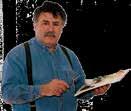

Samir Sammoun
of Special Merit Honoring The Spirit of CreativityWith Exceptional Contributions & Significant Achievements FINE ART MAGAZINE 2016 HALL OF FAME AWARD Victor Bennett Forbes EDITOR-In-CHIEF Jamie Ellin ForbesPUBLISHER PRESENTED BY SUNSTORM ARTS PUBLISHING CO., INC. • NEW YORK CITY
Artist

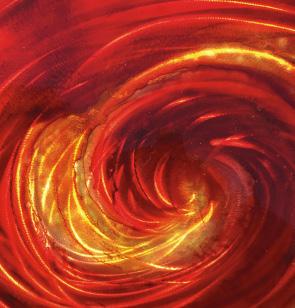

C
Y
N
SAMIR SAMMOUN STORY
y Victor Forbes SPECIAL EDITION ON LINE & IN PRINT ★ ★
HER OF
REAT VIT
SAMIR S A MMOU
THE
WALKING WITH GIANTS B
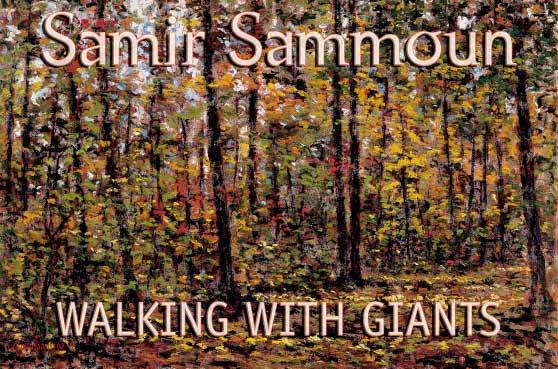
Samir Sammoun has created a deep and important body of work in two diverse fields — science and art. In the former, where, he notes, “one plus one always equals two,” his research has played a major role in developing a fundamental tenet in telecommunications systems employed universally. In the latter, Sammoun is also engaged in the process of creativity, research and development except here the answer to the question “How much is one + one?” could, he says, “just as easily be one hundred.”
Even with such great success in engineering, it is his art that defines him, and his paintings are inseparable from his very being. Sammoun’s fervent desire is that his output allows him to become a viable link in the chain of masters who are recognized not just by the cognoscenti, but the masses. Can it be said that Samir Sammoun is in the midst of the elite who converge on the path where public and critical acclaim meet? Time will tell. But from one whose life’s profession involves the search for greatness in artists, it can be confirmed that Samir Sammoun will not willingly allow his goal of hanging side-by-side in museums with the chosen few go unaccomplished.
B y VICTOR BENNETT FORBES Editor-in-Chief
Samir Sammoun guided the Jaguar through the streets of his adopted hometown, Montreal, with the gracious ease of the comfortable. The Jag, of recent vintage, not brand new, but spiffy enough to have just left the showroom floor, took to the postChristmas traffic with singular purpose. Samir steered effortlessly as the beast beneath hugged the pavement. Just like the ads. “Over on the left,” he said, “is the Temple of Joseph, which I have been commissioned to paint.” I hunched my shoulders and bent deeply at the neck to get a better glimpse. Even under renovation, the majesty of the structure could not be hidden. A huge dome spoke in the language of the universal believer in a mosque-like architectural guise. For a moment, one could see here a headquarters for people of faith and love where the great religions of the world could ascend with their very own personal savior into the heavens. It was a fleeting thought, with the cross gleaming in the moonlight night, filtered through the holiday brightness of the big city. As we headed a little further out of town, to a Lebanese seafood restaurant, the conversation turned from eternity to art.
“I have been with van Gogh,” said Samir. “I understand him. We spent a good deal of time together. ” Any observer of Sammoun’s paintings will readily understand this statement, spoken so matter-of-factl y, as unexaggerated truth. With powerful colors delicately applied to form minute details that comprise perfectly devised compositions, one cannot help but note the continuum. Samir ’ s respect for van Gogh, arguably one of the purest creative entities ever, is evident throughout his work in much the same way that Keith Richard ’s guitar stylings are informed by Chuck Berr y. High level talents, mining similar streams, evolving to and sometimes hitting upon perfection. As great as he was, not every painting is Starry Night , as not every riff is Jumpin’ Jack Flash.
With his eyes fixed firmly on the road, Samir continued. “van Gogh did all his production in ten years, starting at the age of 25. He was my first inspiration when I started painting in adulthood. I was kind of living with him in the same atmosphere, the same ambiance…”
Samir didn’t say whether he stayed for the tragic end — the mutilation, the misdiagnosed madness, the overwhelming joy and sadness of a great person equally sym-
19 • Fine Art • Spring, 2003
Automne sous bois (Autumn in the Woods), oil on linen, 40 x 60, from the collection of the Plattsburgh College Foundation Museum, State University of New York
pathetic to subjects human and of nature. If he did indeed watch the finish, he somehow emerged intact. The best of van Gogh — the pearl of great price — lives on in Sammoun who seeks to capture his unique ability to convey the infinite depths and heights of emotion, filtered through the fiery passion of his paintings. The expression of God’s love for his creation is what consumed Vincent and is the base point of what is necesary to drive every work of art that will reside in the museum of eternity, picked by the only curator who matters.
Samir Sammoun must know, somewhere in his psyche, that to accomplish his own goals, he must continue to walk with the giants.
Samir was greeted, fawned over, actually, by maitre d’, owner and chef at intervals, all making sure the full repast of middle eastern delights was to our liking. I would print the entire menu here if space allowed but let it simply be said that plate after plate of appetizers were brought to our table all equally delicious and from every food group. Our fish was broiled to perfection, accompanied by wonderfully prepared prawns. Dinner ended and I was happily exhausted, satiated, quite content to be dropped at the hotel with plans for a meeting tomorrow in Samir’s corporate offices before heading out to his studio on the outskirts of town.
Montreal is a wonderful city, an hour and a half from the Adirondack Mountains of New York. Artists have described to me its greyness, how they longed to leave its long winters for the more colorful climes of the south. Yet, this late December morning shone with the beauty of the season. I met Samir in the lobby of the Delta Hotel, my standard poodle, Blue, in tow, and we walked the few long blocks to CAI Technology headquarters where he still puts in a few hours a day supervising his engineers, managing the finances, and solving some of the more esoteric telecommunications problems. A poodle friendly security guard saw us to the elevator to the offices, which occupied a good portion of the 24th floor with panoramic views of the city and beyond,
The offices were beautifully appointed; not a sheet of paper out of place. Huge windows, perfect view, modern computers, sleek furniture, comfortable, modern, and Samir Sammoun paintings from many eras of his career appropriately adorning the rooms and hallways.
“Ten years of research,” Samir was saying. “It was a decade of work and then all this information came to a focal point in the natural process of communicating. Patents based on my research were and still are registered to the company. My
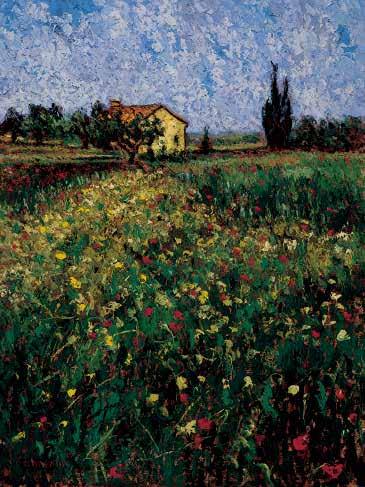
“My soul will always be like this mixture of feeling.”
involvement in engineering put me in a good position; I was vice president of Videotron, first major cable supplier in Quebec. When you do your job with love, everything works — for the company and yourself.”
Now in his own spacious environs, walls bedecked with his paintings, with his work in museums and prestigious collections, Samir indulged his guest with an analysis of the connection between art and science as an information transfer. From here, things get a drop technical for an art magazine, but upon further analysis, one can see where the intellectual process of inventing a telecommunications standard does relate to the process in-
volved in, and has many similarities to, creating important art. “With Telecommunications,” said Samir, “ if you are connected to a cable system, it looks like a branch of a tree and you are one of the leaves. When you hit the keypad to search the net you are sending some exchanging signals down to the trunk of the tree. My job was to implement a process in which all these people on the branches talking to the trunk of the tree would not collide.
For now, though, Samir has his hands firmly attached to the big poodle’s leash as he is guiding us from painting to painting. He possesses a certain indefineable gift, a magic of sorts, that serves him so well in research
Fine Art • Spring, 2003 • 20
and has been readily adapted to his art. Stand before a painting and you understand the draughtsmanship and capacity with a brush, but stand back ten or twenty feet and the painting takes on an entirely different value. Specifically, from close-up you may see nothing but from backing away, everything will be apparent. It is not perspective, it is not coloration, it is not the layering or the buildup and three-dimensionality produced by brush-strokes. Nor is it a conscious gimmick. The paintings simply emanate a certain presence from a distance, a macro/micro kind of thing, and this is one element that sets his work apart from that produced with the restrictions of the less gifted. Up close, colors may appear random but they are organized and built up in a succession of layers. The sway in the field is no accident. Colors are not melted together, they are one beside the other. You can see many in the same stroke.
When he paints, amazingly enough, he doesn’t think a lot of what he seeks to achieve as a final result. It is an experience by itself and he is anxious to see what the final result will be. Every painting is like this. When Sammoun executes the painting, he knows the subject, though there are a lot of haphazard, unintentional things happening. It is not like he is doing a realistic painting. Everything is rendered to his taste.
“There are several things that come into play when you are devising a telecommunication set-up,” Samir continued. “There is a multi-access protocol, which is a protocol of talking. Imagine you are a professor in a class and you are addressing your students. When you
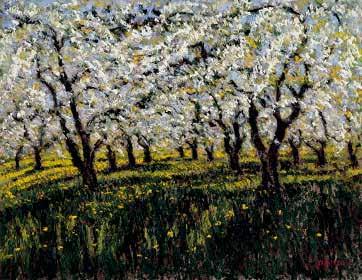
speak, every person can hear you. As you are the only person talking, you are like the transmitter or trunk of the tree sending signals to the branch. If one student at a time wants to address you, you can hear; when three stand up, you hear nothing, they are colliding. You then have to make a protocol, of which there are many. For example, one after the other talks, letting the other talk and then the other. When I know you are finished, I pass the signal to the next — this is polling protocol. You are the master of the process
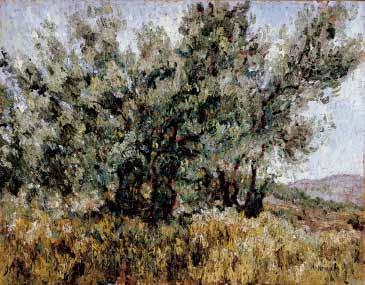
and everyone has his time. This is not effective because it takes too long and you don’t know who wants to talk —it’s very cumbersome finding out. Another protocol is the aloha protocol. When you want to talk, you stand up and begin; if at the same time somebody else gets up, you start to execute a random algorithm in your mind. ‘I will talk in half a minute.’ Another says, ‘I will talk in a minute and a half.’ This is a multi-access protocol, where a random delay is employed to let people know they are colliding.”
You need a collision detecter, somebody sitting in the trunk who says “Whoa, you are colliding.” Then talking is stopped and a random algorithm executed to stop and start talking.
The trunk of the tree becomes an important motif in Sammoun’s art, a reflection of the strength of these thousand year old groves, tempered with an underlying sadness inherent in the human condition. “Recently, a friend who is also a psychotherapist was analyzing me through one of my olive tree paintings. The olive tree is a subject very close to my heart because I was born in Lebanon and from the age of four, I began to participate in the harvesting of olives with my entire family. The trees bear their fruit once a year in autumn, around the start of the school year.” Samir fondly recalls those idyllic days and is anxiously awaiting a package from “home” sent by his father containing a few gallons of the year’s first pressing of olive oil. “It takes two months by boat, from my village atop the Chouf Mountains.” Wonderful memories of a peaceful childhood
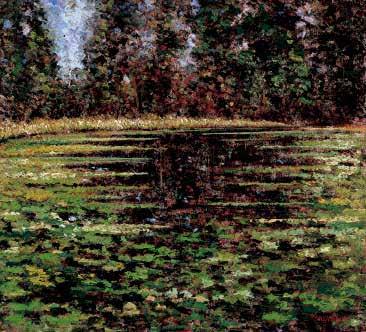
are tempered somewhat with the harsher realities of adulthood — the proverbial thorn in the side — so the darkness of the olive tree’s base, combined with the beautiful reds and greens of the leaves on the branches very much reflect his psyche. “For the olive tree trunks, which are dark in reality, I use prussian blue which gives me a very strong contrast between light and dark. She says I am happy and sad at the same time. My art is a very intense internal process and my soul will always be like this mixture of feeling.”
The second part of the invention covers the fact that you cannot have a lot of people talking at the same time — The Earlang Theory upon which the telephone central network works. Every home has a line going out to the public branch exchange, the box in the street. Maybe 500 lines go to the same box. From the box going to the central station, there may be 50 or 70 lines, but every time you pick up the line to call, you always have the dial tone. This is why when you have catastrophes like earthquakes, there is no line open as everyone is talking. I did fundamental research and simulations of what is the reality of the thing in cable network environment. It’s a very complicated process but I loved and still love research. In my office, I advise my engineers as to how to do the right thing. I give them the guidance to execute their work. It is very technical, not research,
but something that I enjoy. The basis of the invention is to solve the problem of multi-access communication over the cable network and to eliminate noise gathering over the process.
As is the basis of art. Eliminate the noise, get the message through. Have many speaking at once, but somehow avoid the confusion. It’s as if that tree trunk is Samir’s flowering heart nourishing the branches on his olive trees, the lillies, the wheat fields. All this energy from such a quiet man. A man so unassuming and easy to get along with he says, “If you can’t be my friend, you cannot be anyone’s.” Yet, there is a power in his softness, a quiet in the explosion of color. It is indeed the flowering heart, a well-spring of perfectly constructed energy that captivates all who come in its path.
It is the branches on his trees responding, being silent, allowing others to get through. “When I’m in the execution of the painting, doing the painting is very intense, but amazingly enough a relaxing process Why? Because I am discharging energy into it and afterwards I feel just great. Emotionally speaking, the process most demanding is mixing the color.” Sammoun’s colors do not come out of the tube with the exception of Prussian Blue, Cadmium Red, Olive Green and Titanium White which are often used pure and actually applied at the finish, the last
moment. Everything else is a mixture of different colors with the same hue from canvas to canvas in the same series. The subject is also a very demanding process. “I choose only those that I love and want to paint. What is it that I really want to do, and how do I get this on canvas? It has to be something that I would like –the perfect subject for me. Then I have to have the canvas prepared with the first layer of burnt siena and a few other technical secrets.
Blue and I followed Samir and the Jag in our Impala to his home in a quaint suburb a short drive from downtown. His wife, Yvette, a pharmacist who owns her own business in Montreal is getting ready to go to work. We take some time, have a sandwich and a glass of wine and take a tour of the house. Downstairs is a very well-stocked wine cellar, upstairs is his studio. A fairly small room as neat as his car, office and the rest of the house. Not sterile, but very neat. Order is everywhere. White canvases are lined up,waiting for their siena overcoat. Tubes of paint, a well-used palette, brushes, an easel, photographs, magazines and printed matter. Such coherence, cleanliness, calm. His studio window overlooks a small back yard. Blue and the Sammoun’s dog, Flappy, are playing outside. For all the greyness of Montreal, there is a powerful light

coming in the window.
The particularity of his process is allowing this light to get through. You look at any Sammoun painting and find no busy signal. All is clear. Where the light is, you find a harmony of colors. Sammoun uses an underlay of burnt siena to bring everything together. Any other color, and the painting would take on a whole other personality. In managing this important and delicate process, the artists is in constant dialogue with himself. “If I want to paint a field of wild flowers, I ask, ‘What do I see.’ It is an engineering process often involving a juxtaposition in layers of color. When I change the position, the layers change. They are re-
Samir with Elliot Blinder of Marco Fine Art
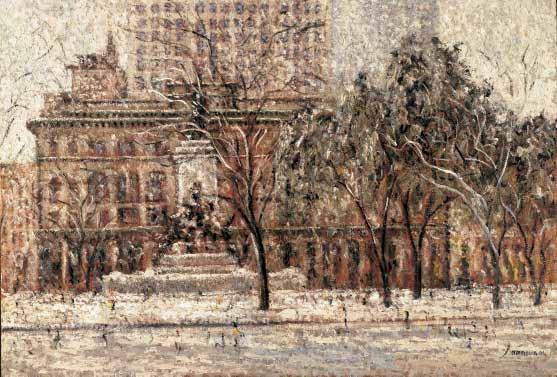
ally random, still the same scene, but completely different shades of color.”
So as the artist walks to see the scene from another angle, he’s in the field. Layers of color are there in a random process. Sound familiar? “Random colors are layered on top of the others and I say to myself, this is what I should do.”
Sammoun’s scene is composed of 20-30 hues of colors organized in a way that gives a tree or lillies on the water what each needs to ring true. “If I create on my canvas a random process the way I see it, I should arrive at an interesting result. This is why these spots on my palatte must be in harmony. From my brush I take a little part of here, a little part of there, but they are distinguished, like in a spoon you would have a little bit of yogurt, a little bit of marmalade. You can do mixing, of course, but I often have as many as five distinct colors on my brush. One dip of each color and I make my stroke.”
“I think I’m still young as a painter,” says Sammoun, 50, as we are preparing for the drive back to the Lodge at Lake Clear. “There is a lot on my mind. Subjects I love. I would like to create 500 olive trees paintings, wheat fields, willow trees with water,
apple trees in blossom. I have a lot to do and the work will be a continuation of what I am doing now. Something that will enhance what I have done, progressing with continuity. There are also many subjects I haven’t explored yet. As long as it is creative, something that I love doing, I will give it consideration,” says the artist who began painting in earnest at the age of ten, gave up at 19 to come to the University in Montreal to study engineering, and began again at 30. “The process of me finding my technique and coming to this level was fast.”
While museums and government offices own and display his work, Samir relishes his relationships with collectors, one in particular. “He is Vietnamese, an accountant, who has fallen upon hard times. I offered to buy back the paintings, but he refuses to let them go. ‘How,’ he asked me, ‘can I sell you back something that I talk to every day for 20 minutes before I go to work.’”
Sammoun’s objective for each of his paintings is for them to sit on a wall surrounded by other great paintings. “Every artist thinks like this,” he states. “I visited a lot of museums and you can assemble a good number of my paintings and they are museum quality and that’s
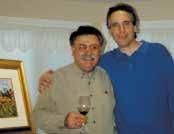
what people are telling me and I believe them. I’d like to be considered in the same breath as the great masters, as those whose works I have studied and admired for hours on end in many museums of the world.”
A lofty aspiration, one might say, others might view such hopefulness as an inspired goal, or perhaps lunacy.
Yet, it seems that a man who can figure out which logarithms are required to prevent logjams in the cable network certainly has the imagination to discern what it will take to become a recognized participant in the Battle of the Giants, in which, as the old Pioneers song goes, in order to live, what you have is what you must give.
Artist and writer, Sammoun & Forbes
CATE CHIRICO, PHOT O

Samir Sammou n The Last Impressionist Takes London


Fine Art Magazine • Autumn 2019 • 31
after a long day at the START ART FAIR in London at Saatchi Museum
Toasting with Corinna Steiner of Vienna’s The Gallery Steiner
Samir Sammoun Field of Poppies and the Meditarrenean Sea
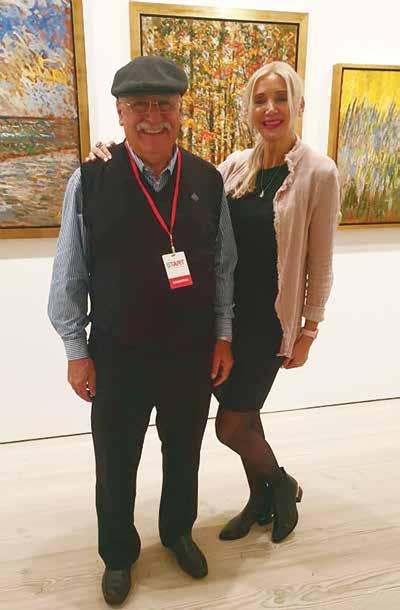
START Art Fair 2019 received an overwhelming volume of top quality artist and gallery applications from all around the globe, our only regret this year is not to have been able to offer all of them space to exhibit. Some of the team’s personal highlights include: The Gallery Steiner who embodies START’s ethos of supporting emerging artists by occupying not one but two top-floor gallery spaces, where they presented Samir Sammoun who has never been shown in London. The Gallery Steiner is a modern art gallery in the heart of Vienna. Located at Kurrentgasse, one of the most prestigious locations in the city, the family-owned institution founded by Michelle Steiner, Corinna Steiner and Dominic Steiner embodies their mission to represent professionalism, modernity, diversity and internationalism.
Since its foundation in June 2008, the gallery has established itself as a meeting point for qualified art collectors and a hub for internationally recognised and emerging artists.
The gallery STEINER only represents living artists from Europe, Asia, Australia and North America who are exhibited regularly in group and solo shows at its premises in Vienna as well as at international art shows.
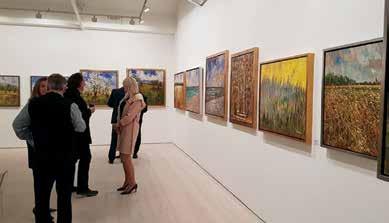
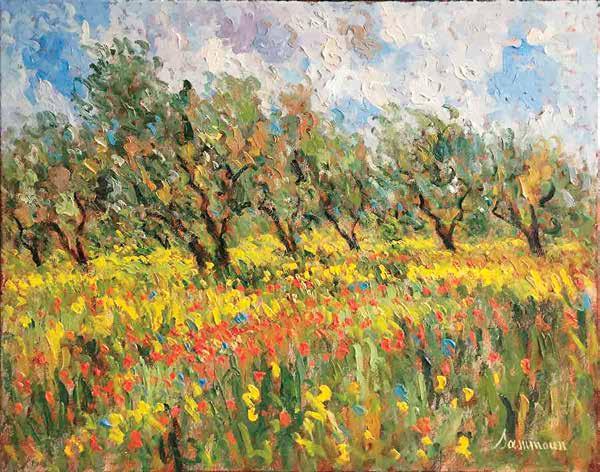

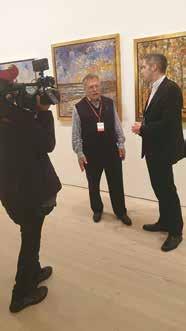
32 • Fine Art Magazine • Autumn 2019
Samir Sammoun, Corinna Steiner at the booth START Art Fair, London
Walls of Sammoun originals
Interview with Dominic Steiner
Samir Sammoun Olive Trees and Poppies

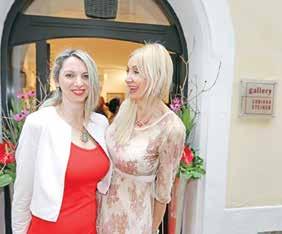
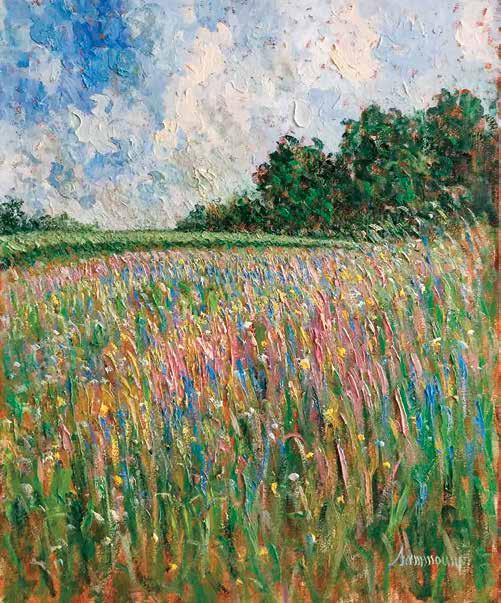

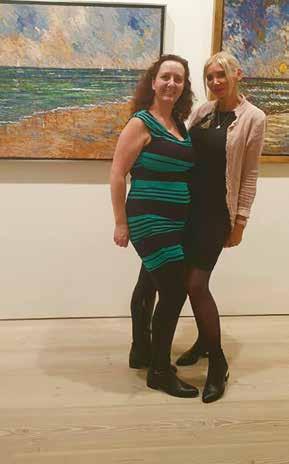
Fine Art Magazine • Autumn 2019 • 33
Sunrise on the
2015 Oil on linen canvas 119 x 102 cm
Michelle Steiner, Corrinna Steiner
Beach,
Lupins Field 2015-2016
Fay Beauchamp Galeriste and Dominic Steiner
Samir Sammoun, Tayo Oyekoya, Corinna Steiner and Dominic Steiner.
SAMIR SAMMOUN
Extolling the Virtues of Peace Via A Life in the
Arts
“Sammoun has indeed built upon history to develop a personal style that is reflective of his inner being. Nothing is held back by these emotionally charged canvases that capture the essence of Nature as recreated by Man, in this instance Samir Sammoun.
— Constance Schwartz, Director and Curator Nassau County Museum of Art, Roslyn Harbor, New York
By VICTOR FORBES
One of the most sought after and beloved artists working in North America today, Lebanese-born Montréal-based Samir Sammoun closed out 2011 with a sold-out collection at Boston’s prestigious Galerie D’Orsay. Featured in the exhibition were Sammoun’s masterful works on canvas of olive groves, fields of flowers and cityscapes along with his new bronze Olivier I, a self-contained prototype of his vision to develop this sculpture of a singular tree into a series of life-size replications to be installed as symbols of peace in public parks and gardens around the world.
“Sammoun’s body of work is an in-depth depiction of the connections he makes between his long-time residence in Montréal and birth and childhood in Lebanon. Painting and sculpture emerge as statements of common familiarity to be shared by all. His admirers enter into a personal involvement with the work making him a man for all seasons of expression through the universal language of art, notes Jamie Ellin Forbes, Director of the Fine Art Museum of Long Island (1990-1995) and publisher of Fine Art Magazine The compelling power of his vision is truly informed in the majesty of the new sculpture created in the age-old Lost Wax method. The table top model, a 18” finished piece that serves as the maquette for the highly anticipated fullscale version, is imbued with a vital energy that summons a rare combination of awe and comfort to the viewer.
As a boy growing up in the Chouf Mountains, south of Beirut, Sammoun has fond memories of an idyllic life centered around harvest time in the olive groves. “The olive tree is a subject very close to my heart,” he declares, “because from the age of four I began to participate in the harvest with my entire family. The trees bear their fruit once a year in autumn, around the start of the school year.”
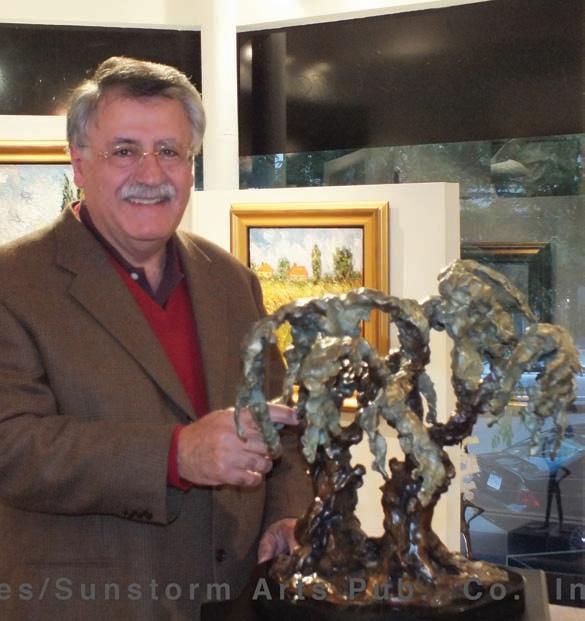
was a rendition of an olive grove from his father’s land, a 48” x 72” canvas that was shown to great acclaim at the International Artexpo in New York City. Introduced to the work at this major art fair, Roslyn (New York) Museum Director and Chief Curator Constance Schwartz went on to compose these words in the introduction to Sammoun’s monograph, aptly entitled Walking With Giants: “With dramatic flair, an attractive, energetic and brilliant communications engineer, Samir Sammoun, follows the path of the Impressionists… enriching their characteristics with his unique and personal vision… and a more adventurous and experiential approach in terms of his involvement with the formal aspects of painting…Brushwork, composition and color take on a life of their own in the painter’s process.”
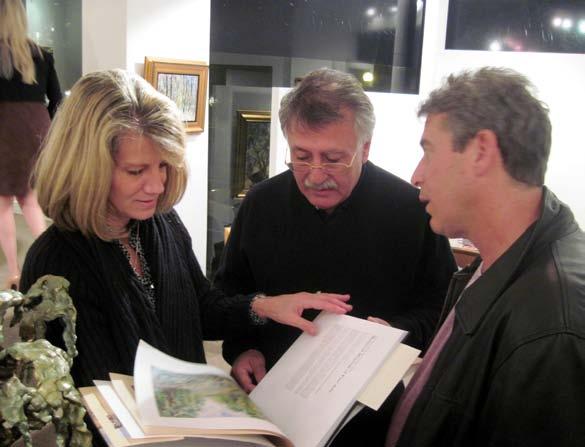
Sammoun seeks to share that cherished era of blissful childhood memory by recreating the spiritual and physical landscape with this major project that pays tribute to his homeland’s pastoral scenery and vibrant tradition. The olive tree possesses a majestic lineage dating back to the great flood when Noah’s dove returned to the ark with an olive branch, declaring that land was near and civilization could resume.
The initial painting that launched Sammoun’s “Peace Project”
Sammoun’s dream— his vision, in addition to the sculptural installations—is to create a mosaic of a full-size olive grove suitable for installation in public buildings, such as the United Nations or in a great room, as in a museum, with a perhaps 100 paintings hanging next to each other, designed so that when put together the result will be powerful.
“The harmonious nature of these vistas represents the different themes of life and the various joys with which people live and are designed to inspire feelings of peacefulness, first amongst individuals, then to be expanded to nations and ultimately the world,” says the artist.
“The olive grove in all its majesty and simplicity,” continues Samir, “is home to the tree of life. When you enter an olive grove, you are at peace with yourself and there is a wonderful silence. The olive is a complex plant yet a simple tree. The back of the leaf is silver, the front dark olive green. They flicker, so there is just a little bit of
Fine Art Magazine • Spring 2012 • 11
Samir Sammoun at his sold-out exhibition at Galerie D’Orsay, Boston, MA,
Collectors viewing Sammoun’s book, Walking With Giants
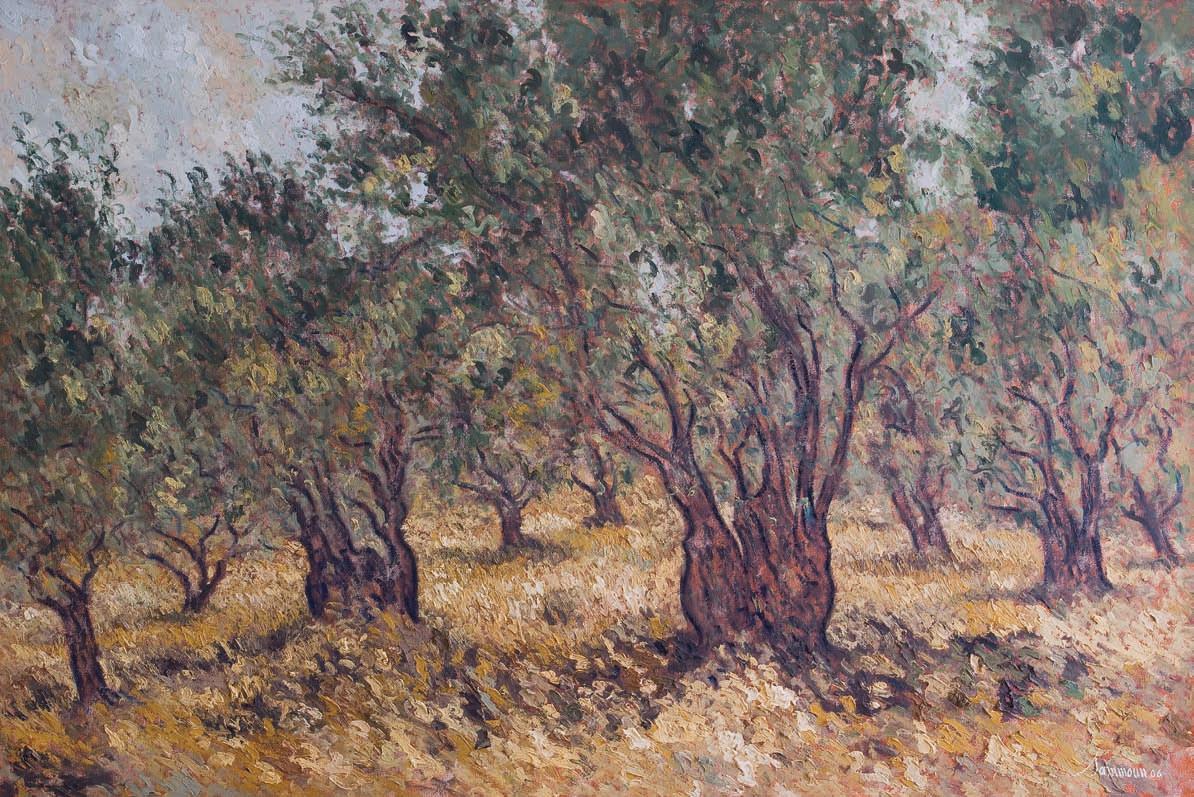
magic there. The beauty of the groves is special just before harvest. I render the atmosphere as it is to transmit the peace that you feel when you get into this place. What I really want is for the peasant from the mountain to tell me, ‘This is the field I just labored in yesterday.’
“This is the work for which I long to be remembered. I am continually fascinated by the grove and the simplicity of its significance thus venerating this tree.”
In creating the new sculptures, Sammoun relates, “I imagine it in my mind from my childhood. The trunk of the tree becomes an important reflection of the strength of these thousand year old groves.” With distant memories tempered with the harsher realities of modern times, the darkness of the olive tree’s base, combined with the beautiful silver and olive green of the leaves on the branches, very much reflect his psyche.
“The olive tree trunk presents a very strong contrast between light and dark, expressing happiness and sorrow at the same time. My art is a very intense internal process and my soul will always be like this mixture of feeling.”
a few who feel it as you and I do”.
(Letter by Vincent van Gogh to Paul Gauguin. 22 January 1889)

An admittedly fervent disciple of van Gogh, the spirit of Vincent is ever-present in Samir’s works with swirling movement of paint giving life to traditional landscape elements so that they take on a mystical atmosphere of ethereal unity amidst the intense activity of his line. This dynamism is always natural as Sammoun makes the mountains, fields and trees dance like waves, channeling the pure and primitive energy of his hero. Without fanfare but with great dramatic effect all the more memorable for its subtlety, Sammoun magically sets himself apart from every other painter seeking to represent nature. His works are one of a kind, and he is not able to make the same painting twice.
In addition to The Peace Project, Samir dedicates his artistic energies to fundraising for juvenile causes. His exhibits at the adjunct gallery of the Montreal Museum of Fine Arts and the Marc-Aurele Fortin Museum in Old Montreal have raised considerable sums for the Saint Justine Children’s Hospital. Continually growing as an artist and humanitarian are Samir’s primary goals.
Ah! My dear friend, to achieve in painting what the music of Berlioz and Wagner has already done…an art that offers consolation for the broken- hearted ! There are still just
“His talent and highly personal painting style…are enthusiastically received by collectors as well as the academic community,” comments Jacqueline Hébert Stoneberger of the Plattsburgh State Art Museum, which holds two of Samir’s originals in their critically
12 • Fine Art Magazine • Spring 2012
Olivier, bronze, 18” ht...
Olive Grove Before Harvest, 48” x 72”
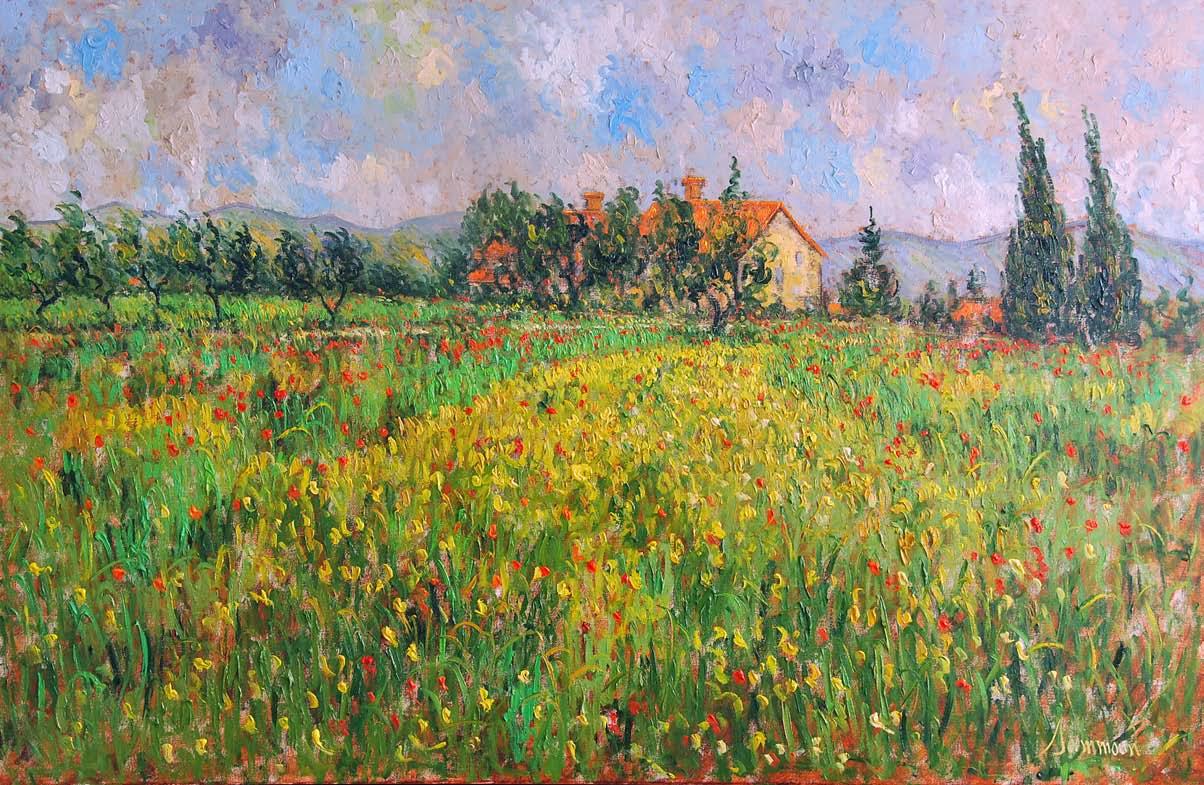
acclaimed permanent collection. Sammoun’s ability to transform his visual perception into a material form, expressing what he perceives, represents the history of art in a unique mode of expression. Sammoun offers a very personal and accomplished visual perception in the long chain of the giants of art history; a very specific and unique contribution to the ways in which man “sees” the world.
All this energy emanates from such a quiet man. A man so unassuming and easy to get along with he says, “If you can’t be my friend, you cannot be anyone’s.” Yet, there is a dynamic in his softness, a quiet in the explosion of color. It is indeed the flowering heart, a well-spring of perfectly constructed energy that captivates all who come in its path. It is the branches on his trees responding, being silent, allowing others to get through. “When I’m in the execution of the painting it is a very intense, but amazingly enough, a relaxing process. Why? Because I am discharging energy into it and afterwards I feel just great.”
As proprietor of Galerie D’Orsay, a prominent gallery in a city known for its historic and vibrant art scene, Sallie Hirshberg has been instrumental in presenting Samir’s work to the city’s prestigious Boston Museum of Fine Art where a number of his paintings have been selected for inclusion in annual fund raising campaigns. “We are quite proud to represent Samir,” she said in recent interview. “There is no one like him. He is full of life, generous of spirit, and an amazing painter. Samir has been with us a good seven years and every show that we have with him is a sold-out exhibition. The collector base for his work is quite eclectic, comprised of people of many backgrounds and nationalities. He has
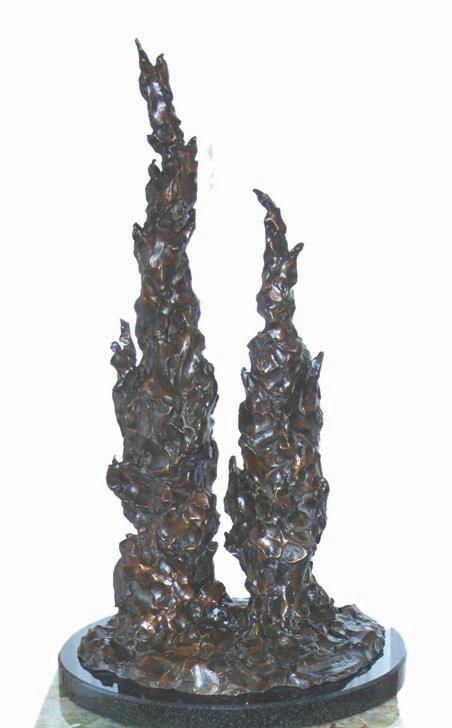
built a wonderful bridge, creating a connection between people of different cultures who all love one artist. We have so many people who fall in love with his work.”
Walking With Giants is a phrase coined by an art writer who has spent many days with the artist, touring Montréal restaurants and museums, collecting responses from curators and directors and basking in the glow of a room surrounded by Sammoun’s master works. This title not only reflects an action— walking—but an objective. Samir’s fervent desire is that his paintings reside on a wall with other great paintings. While “genius” is an over-used and over-wrought phrase to describe an artistic talent, in Sammoun’s case it is justifiable if you take the definition to mean being able to convey perfect love, hope and harmony via one’s own creativity. In this case, Sammoun is undeniably a master, a genius if you will. His presentation is not clouded by delusions of grandeur or shallow artistic temperament cloaked in a body of work. There is no disrespect for his gift, his audience or those who came before him. Even in a long line of giants, Sammoun stands tall amongst them. His place in art history is secure and growing in stature as more become aware of his work around the world. While museums and presidential palaces own and display his output, Samir relishes his relationships with his collectors, one in particular, a Vietnamese accountant in Montréal who had fallen upon hard times. “I offered to buy back the paintings, but he refused to let them go. ‘How,’ he asked, ‘can I sell you back something that I talk to every day for 20 minutes before I go to work.’”
Fine Art Magazine • Spring 2012 • 13
Tuscany, Winery on route between Florence and Sienna, 48” x 72”
Cypresses, bronze sculpture, 24” ht..


SAMIR SAMMOUN: A PAINTER’S VISION
By VICTOR BENNETT FORBES
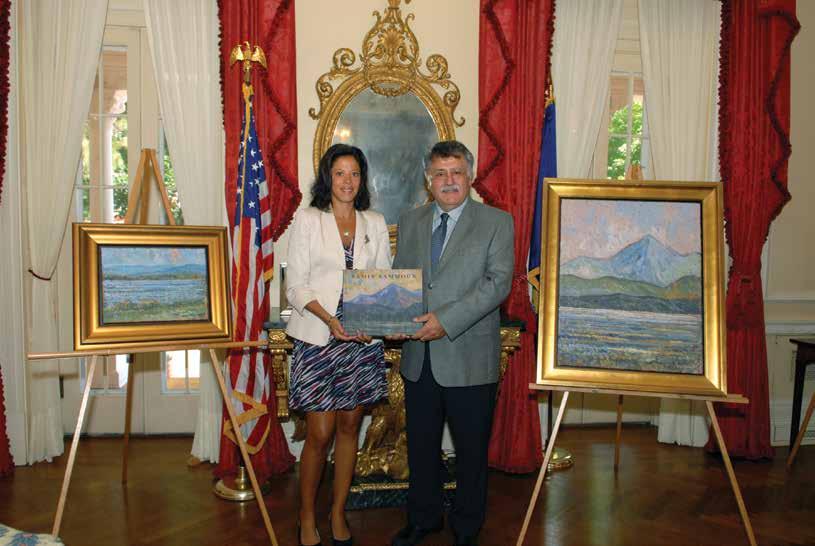
Samir Sammoun’s Views of Lake Champlain
With decisive brushstrokes and vibrant colors, Samir Sammoun is painting a dramatic new chapter into the glorious realm of Adirondack art history, joining the ranks of such notables as Thomas Cole, Asher B. Durand, Winslow Homer, A.F. Tait, Rockwell Kent, Harold Weston and many others who have found inspiration in the rugged terrain and idyllic beauty of the north country of New York state.
In Sammoun’s new landscapes, created especially for the 400th anniversary celebration of Samuel de Champlain’s “discovery” of the lake that bears his name, there is a nobility, a quiet dignity and an awesome feeling of exuberance. In their stillness, there is great action, reflecting the unity of creation and creator. Under the skillful realm of a master such as Sammoun, subject matter and work of art are intricately woven by the eye and hand, to become painterly extensions of thought and spirit, far more than reproductions. Sans fanfare, but with great dramatic effect all the
Burke Gallery, PlattsBurGh state art MuseuM, state university of new york more memorable for its subtlety, Sammoun magically sets himself apart from every other painter seeking to represent nature through his or her singular impressions. In his delicacy, there is a power. A sole flower, one among many in a sun-drenched meadow, is as memorable for a singular droplet of the most brilliant red as it is for its membership in the entirety of the composition. Sammoun handles the fate of his depictions as if the individual images were characters in a novel, or a lengthy poem. Like a flower, these paintings bloom, but unlike a flower, they do not fade away. In these works, there is ample opportunity for a casual viewer to enjoy a happy natural scene, as well as to take a deeper look into serious matters of the human condition through the Romantic notion of perfection.
By VICTOR BENNETT FORBES
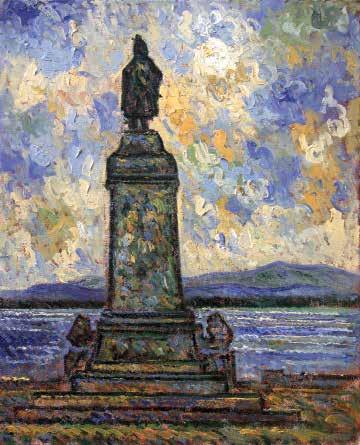
30” x 24
The brilliant canvases are imbued with Sammoun’s trademark impressions and passionate interpretations of the landscape for which he is known around the world. As
Samuel de Champlain Monument, Plattsburg
Samir Sammoun presents his new book, Walking With Giants to Michele Paige Paterson, First Lady of New York State, at the Governor’s Mansion, Albany, NY

a disciple of van Gogh, the spirit of Vincent is ever-present in these works with swirling movement of paint giving life to traditional landscape elements so that they take on an almost mystical atmosphere of ethereal harmony amidst the intense activity of his line. This dynamism is in perfect harmony with the rugged yet accessible terrain of these ancient mountain ranges in New York and Vermont, divided by Lake Champlain, in a region which has become a mecca for visitors from all over the world and somewhat of a bucolic paradise for those who make these parts their year-round home.
In this current body of work, featured in a one man exhibit at the Plattsburgh State Art Museum’s Burke Gallery, State University of New York at Plattsburgh, Sammoun travels back some four centuries in time, following the trail forged by Samuel de Champlain, depicting scenes of Lake Champlain as the noted European explorer might have encountered them. These paintings were a result of a challenge made to the artist several years ago by Celine Paquette, vice-chair of the Hudson-Fulton-
Champlain Quadricentennial Commission. “I took him on the lake on the northern end and southern end, and by car to Crown Point and Ticonderoga,” Paquette said. “I told him, ‘You have to see the lake and Adirondacks from the Vermont side,’ and we went to Burlington.”
Sammoun then studied the history and Champlain’s life in great detail and with great sympathy for the explorer who was forced into battle in which he killed a number of native chiefs who had been his friends and benefactors at one point. The two paintings of Ticonderoga, at daybreak and midnight, reflect the solemnity of the day’s activities to come, the tranquility in the battle scenes— before and after. “I wanted to depict that calm as it was described in historical accounts,” said the artist in a recent interview. “It was a quiet, nice morning with the sun coming up slowly. The air is fresh, life is beautiful and then the battle came. I wanted the scene by midnight of the same day to be very moving. Champlain battled against his will, he killed two chiefs and was sorrowful, that’s what history said and there is a certain sadness evident in the Ticonderoga scenes. The entire
commission was very challenging as most of my prior work had inherent movement in the diasporas. In these compositions, the environments were inherently restful, yet required movement. I struggled somewhat to put activity in the scenery by playing with the sky and the water. I sought to make the mountains move and look like waves and channeled the pure and primitive energy of van Gogh to make that happen. The task was really to paint the lake and its surroundings and I enjoyed it very much as did many of the people I met who lived around the lake and appreciated and recognized the authenticity of these particular works.”
At the artist’s June 3, 2009 opening reception at the Plattsburgh State Museum, it was Ms. Paquette who escorted the First Lady of New York State, Michele Paige Paterson, who was feted as the Guest of Honor. “We’re certainly deeply honored she visited us and spent time with us,” said Ms. Paquette, who also noted, “She appreciated Samir’s work.” So much so that two of his paintings were selected for exhibit in the Governor’s Mansion in Albany by the First Lady.
Dennis Anderson, Director of Curatorial
Ticonderoga Fort Entrance, Autumn, 2009, oil on canvas, 30” x 36”
Lake Champlain and Camel’s Hump Mountain, Autumn, oil on canvas, 30” x 40”
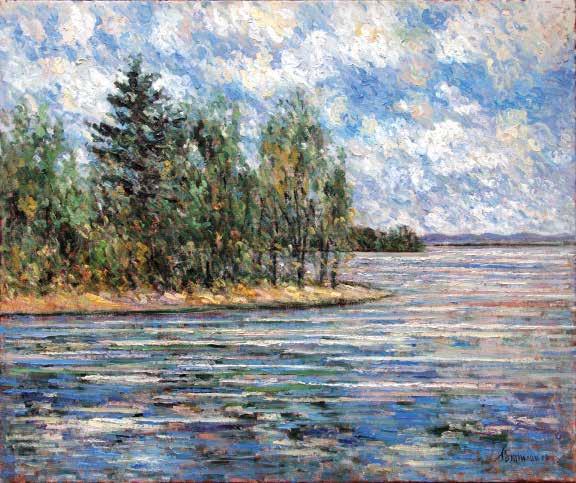
and Tour Services in Albany arranged for Sammoun to present the paintings in the State Capitol. Mrs. Paterson selected Lake Champlain and the Adirondacks, Sunrise, View from Burlington (2009 oil on canvas, 30 x 24 inches) and Lake Champlain and Vermont (study 2008, oil on canvas, 12 x 16 inches) for the display, which will be on view for one year. The artist was duly impressed by his first visit to New York’s capitol. “The mansion is a beautiful place,” he said. “There are paintings from the Metropolitan there. The First Lady has wonderful taste—she picked two of my favorites. It’s an honor for an artist to have this kind of exposure. I’m very happy with all that. Hopefully, there is another occasion to do other things for the State of New York.”
No stranger to high level accolades, Sammoun’s work is in government collections in both Canada and his native Lebanon, where an original hangs in the Presidential offices. Born in the Chouf Mountains, south of Beirut, Samir was interested in painting and drawing from an early age. To this day, the artist vividly recalls the colourful Mediterranean landscape of his childhood. He finished his studies at the School of Arts and Crafts there and soon after
settled in Montréal to attend (at age twentyone) the École Polytechnique in Montréal earning degrees in electronic engineering and telecommunications. “Notwithstanding the exactness of the science of engineering
that is self-engendered, Sammoun’s art is not diagrammatic but instead reflects the artist’s hand. It is his gesture with the brush and that injects the actual ‘process’ of art immediately into the subject matter of his paintings.
 Ticonderoga, July 30, 1609, 8 am Before the Battle, 2009, oil on canvas, 40” x 60”
Isle La Motte, 2009, oil on canvas, 40” x 48”
Ticonderoga, July 30, 1609, 8 am Before the Battle, 2009, oil on canvas, 40” x 60”
Isle La Motte, 2009, oil on canvas, 40” x 48”
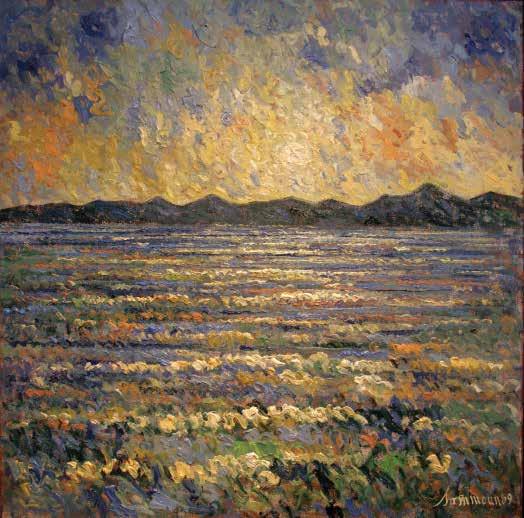
“Reverberations of brilliant light and air in rhythms at play with form and line are evident in these landscapes. Sammoun’s paintings all depict a minimal, exaggerated perspective of a two-dimensional plane having indistinct depth. They provide the viewer with a skin of expressive paint that produces a vibrating tissue of optical sensation in a haunting beauty of glowing color that seems to produce a constant movement throughout the surface of the canvas,” states Constance Schwartz, Director of the Nassau Museum of Art, Roslyn Harbor, NY, in her introduction to the artist’s new coffee table book, Samir Sammoun: Walking With Giants
In the exhibition catalogue, Plattsburgh State Art Museum director Cecilia M. Esposito wrote: “Sammoun uses a contemporary interpretation of the postimpressionist style of strong colors, a thick impasto of paint, and distinctive brushstrokes to illustrate his subject matter. Light and atmosphere play a major role in bringing the paintings to life.”
In so doing, Samir Sammoun continues to build his reputation and more importantly, grow and meet new artistic challenges.
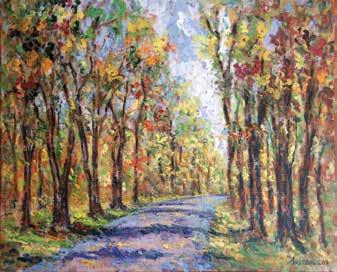 Ticonderoga, July 30, 1609, Midnight After the Battle, 2009, oil on canvas, 40” x 60”
Ticonderoga, July 30, 1609, Midnight After the Battle, 2009, oil on canvas, 40” x 60”


SAMIR SAMMOUN’S MASTERPIECES OF LOVE
In the fury of the moment I can see the Master’s hand In every leaf that trembles, in every grain of sand.
—Bob Dylan, “Every Grain of Sand
By VICTOR BENNETT FORBES
When Elliot Blinder — that champion of accomplished artistic talent — called to make us aware of an artist who merited attention in our publication, Fine Art Magazine, little could we imagine that fifteen years hence we would be composing these words to introduce Samir Sammoun’s monograph. As a life-long friendship developed between artist and writer, the latter continues to marvel at the solid performance of Samir as he rises above the whimsies and challenges of the art world, passionately engaging the fields of creativity in which his masterful representations of the natural beauty of an unpeopled paradise in vivid and sublime portrayals have earned him honor, respect and an everexpanding corps of collectors.
The simple pleasures of life are the hallmarks of his work, colorfully administered to his canvasses. Glorious waves of verdant flowers, spectacular forests with trees of heroic proportions, wheat fields pregnant with nourishment, ancient olive groves that continue to bear fruit, grand mountains, sublime snowstorms, cityscapes and sun-drenched beaches are lovingly rendered in a singular style that can only be termed a “Sammoun.”
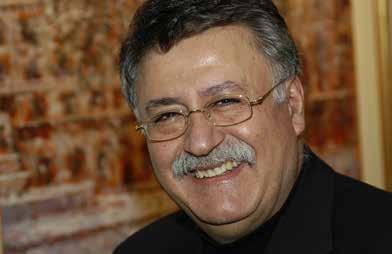

In today’s tumultuous times of sound-bites, 30 second attention spans and fifteen minutes of Warholian fame for all, one can legitimately pose the question of the relevance and importance of an artist whose primary concern is the pure unsullied depiction of nature. What value, then, is there in interpreting, replicating or portraying scenery, whether realistically or via impressions? Do photographs not suffice, or a walk in a meadow or forest? For some, yes but for countless millions who are touched by a sensitive rendering of a beautiful outdoor scene — “unsullied” — there is the landscapist whose sensitivity and skill reveals elements of our home planet that could well be overlooked or missed in our oft hurried day-to-day lives. The gift that Sammoun proffers is one of timelessness, of an infinite static depiction that becomes eternal. The result stops time like a poem. When an artist dedicated to a world vision of peace and tranquility, whatever the worldly situation, as is Sammoun, opts to paint unmodified scenes of real nature, he is shining a light on what could be as well as what ought to be and what was. This Romantic concept hearkens to the very foundations of art and to man’s history on Earth. Who doesn’t long for a sweet vision, a fond remembrance of a beautiful meadow or an ancient forest — a collective memory ordinary or exceptional that is an innocent portrayal of a reachable paradise?
With a style and technique bordering somewhere between the brush strokes of the Impressionists of the late 19th century, the powerful color of the Fauves and even the subtle intensity of the Ash Can School artists (among them William Glackens and Robert Henri) that rose to fame in New York City at the turn-of-the century, Sammoun’s painterly invocations are directly descended from his personal love of and special affiliation with Vincent van Gogh.
Bekaa Valley and Mount Lebanon, oil on canvas, 8”x 10”
Samir Sammon
Fine Art Magazine • Spring 2015 • 1

À la plage, oil on canvas, 60” x 48”
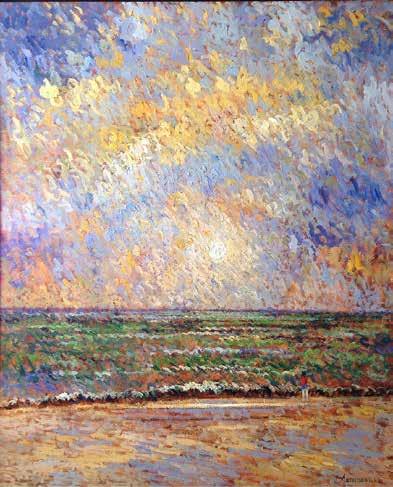
Sunrise on the Beach, oil on canvas, 60”
“Sammoun uses a contemporary interpretation of the post-impressionist style of strong colors, a thick impasto of paint, and distinctive brushstrokes to illustrate his subject matter. Light and atmosphere play a major role in bringing the paintings to life.”
– CeCilia M. esposito, DireCtor, plattsburgh state art MuseuM
On the first of numerous trips to Montréal to visit the artist, he was still involved in his highly successful telecommunications consulting business in which he created the formula that allowed high speed cable signals to share single lines, up and down stream. His offices in the heart of the city were home to many of his paintings. What I recall most vividly about this initial exposure to the work is a conversation in which he related a brief story about one of his early collectors who had fallen on difficult times. Despite an opportunity to sell his Sammoun at a profit, the gentleman could not part with it. “It is with me when I wake up and when I go to sleep, and is of far more comfort to me than I could have ever imagined,” he said. That is the impact Samir’s work has on his collectors. You are drawn into the artists’ field of vision — a peaceful, tranquil space of color and content with soft power to transform an immutable milieu into a passion play of serene works of art that are overflowing in a concise and orderly, yet abundant, stream of life. They are stalwart tributes to the visible nature of earthly paradise, for which our consciousness as a species yearns. Living amidst his masterworks is akin to a permanent meditation. Certainly the artist carries with him his visions as in a special room-full of works, collectively known as “Walking With Giants.” The double-entendre relates not just to the masters who came before him, but to the masterfully painted series of glorious primeval forests through which we all may trod or stroll, depending upon our point of view. Samir makes the walk more than the means to an end. Rather he reveals a path in which each step, each moment frozen in time, becomes an ending and
a beginning unto itself.
As the snow fell softly on the city, we closed in on the art on the walls, so that every brush stroke was visible. There were an abundance of individual units, carefully crafted and blended effortlessly into a composite whole, a distinct entity that is solely Sammoun. All these years later, the subject matter hasn’t shifted — nor has the palate — yet the paintings still retain the significance of the moment compounded with memory … a memory filtered through the visions and dreams of a young boy at harvest season in the mountains of his birthplace Joun, Lebanon on his family’s 1,000 year old olive plantation. (The entirety of his biography and engineering achievements can be found in his Wikipedia entry). The spiritual yet earthly energy emanating from Samir’s work, with the added impact of layered paint upon paint, invokes a mystical aura of sacred perfectibility with child-like clarity drawing us further into the imagery and its roots. It is almost as if the paintings would be on a computer monitor, or your phone, and as you click on the link, you are transported to a magical place image by image, like a slide show. No need for a looking glass, rabbit hole or whirlwind to get you there.
Sammoun soon thereafter left the engineering area of the telecommunications world to devote himself entirely to painting as his work became increasingly in demand, not only by collectors in Montréal, but by an ever-expanding group of quality art galleries from Texas to Boston, and by a number of prestigious museums. Most recently the Museum at the State University of New York in Plattsburgh used a Sammoun painting from their
x 48”
2 • Fine Art Magazine • Spring 2015
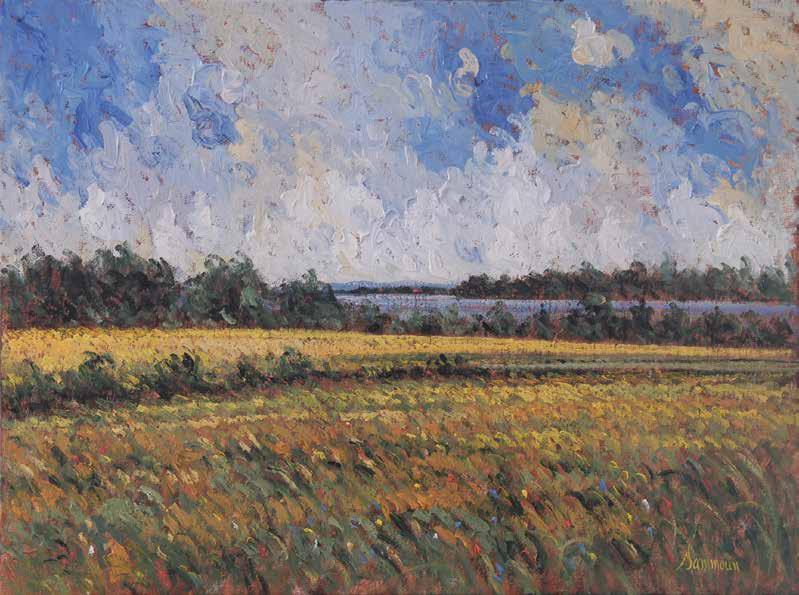
permanent collection as the cover of their Alumni magazine. His dramatic 2009 oil on canvas, Ticonderoga, July 30, 1609, Midnight After the Battle focuses attention on the natural beauty of the area preserved by New York State’s Wilderness Act that has, for the most part, contributed greatly to the well-being of America’s largest park, the 6 million acre Adirondack Preserve (an area roughly the size of Vermont and greater than the National Parks of Yellowstone, Grand Canyon, Glacier, and Great Smoky Mountains combined).
Raised during a period of peace in his homeland (Samir’s brother, unfortunately was killed at the age of 17 in the 1976 civil war), the artist’s earliest recollections were of families from his village gathered together at harvest time in the olive groves, bringing the fruit to the press from which the oil was extracted. As a small
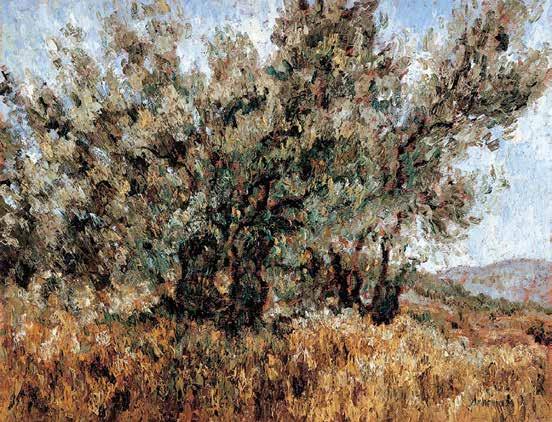 Olivier, oil on canvas, 48” x 60”
Olivier, oil on canvas, 48” x 60”
Fine Art Magazine • Spring 2015 • 3
Mustard Field, oil on canvas, 30” x 40”
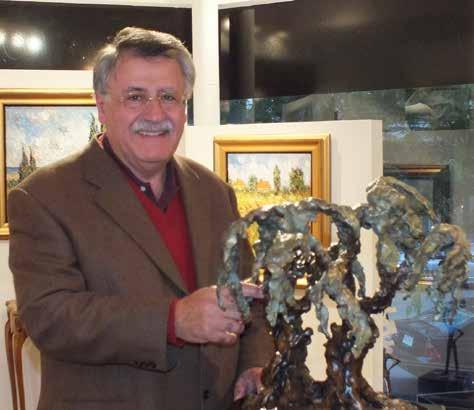

child, Samir was captivated by the activity, especially that of the clanging contraption that produced the liquid. His fascination with the machinery and the process of turning olives into oil certainly played a part in his desire to become an engineer. Years later he would convert those memories into works of art that stand as timeless paeans to the world in which we all abide — a testament to all that is good… despite the long and more than occasionally loathsome history of man.
Because of this, it is a great pleasure to write about Samir Sammoun; to tell you a bit about his life and to weave his story into his art. Samir is like the great musician, who spent a summer by the sea at an early age, practicing his craft, honing his style and walking away from his hermitage with his skills fully developed so that, as is the case with the great instrumentalist, his work from the moment of his epiphany decades ago is almost as it is today in the fullness of his development. This is not to say there has been no refinement or growth — he has developed magnificently — but to a keen observer one can see the connection carried forth from his earliest works to his latest. Getting back to our initial meeting at his offices, perhaps the most interesting element of our conversation was his casual revelation that he channeled Vincent van Gogh when he
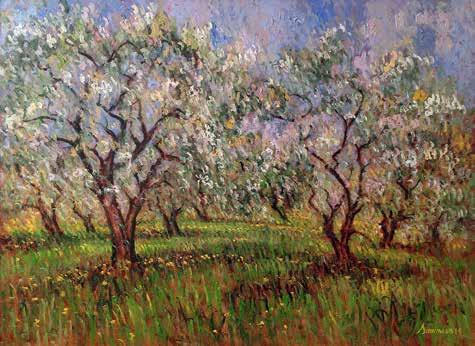
painted early in his career, as if he and Vincent were actually painting side by side. Thus Samir’s work, for a time, was more than direct linear heritage of the one and only Vincent. It was a true interaction with an immortal.You would have to know Samir to understand how radical a concept this was as Sammoun is nothing if not steady, conservative and with the sensibility of a scientist/ engineer. Perhaps it is this process that leaves the door open to the possibility of this matter. After-all, the concept of time and space travel has been around forever and just because one has a staid persona — strait-laced, serious and conventional — doesn’t necessarily eliminate some seemingly farout concepts to emerge. Samir told me this with such casual forthrightness that I just tucked it away and took a closer look at his paintings. While the application of paint to canvas did not possess the swirling, whirling (some might say “tortured”) energy of van Gogh, one could readily notice a continuum of a style — a veritable explosion of life and color in the poppy fields, apple orchards, mountains and cityscapes tempered by the peace of the elegant olive trees and the subtle movement of the wheat fields, ready for harvest.
Vincent created a series of paintings of wheat fields from his that he could see from his cell at Saint-Paul Hospital from May
Olive Tree, Oil on canvas, 12” x 16”
Samir with Olivier Sculpture, bronze
4 • Fine Art Magazine • Spring 2015
Apple Blossom, oil on canvas, 48” x 60”

1879-1880, one of van Gogh’s major series from Saint-Rémy. So many of the elements of Sammoun’s paintings can be found in this group — mountains, cypress and olive trees, changing seasons. van Gogh’s lineage, an inheritance as it were, is carried on magnificently in Samir’s vision. The troubled mind and turmoil in which Vincent resided is smoothed over and extrapolated in Sammoun’s art. He has taken everything van Gogh has given us and converted it all into equally emotional radiant paintings that go deeply into the mind and heart of both artist and viewer. They challenge in their subtlety, in their painterly hues and sharp yet soft depictions of nature. One could look out a window and imagine van Gogh laying it all on the line from his room at the asylum and gaze into a Sammoun painting with many of the same elements in the tradition of Vincent, yet totally original. Sammoun inhabits and creates works of a more peaceful environment, intentionally so, that reflect his own vision. He processes the beauty of the scene, yet in his perfect portrayals, there can be very subtle element of dread. Nothing is forever in this tenuous world. Mountains will crumble, flowers will die, wheat fields may be trampled by invaders or a storm, olive groves and cypress trees wickedly destroyed … yet a painting of lasting value will be honored through the ages. My hope, dear reader, is that as you peruse the brilliant imagery in these pages you will consider not only the beauty of the work but the intent of the artist with no limitations.
And then it happened, right there before my very eyes at the Musée des Beaux Arts in the heart of Montréal, in October,
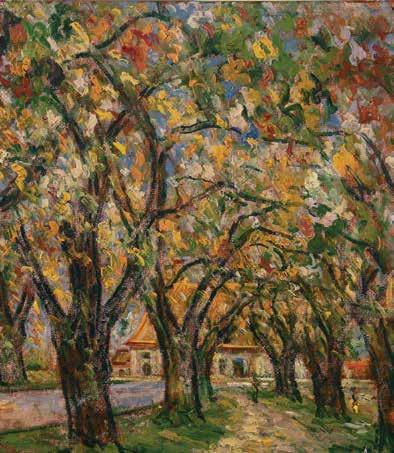
En route to Harvard University (detail), oil on canvas, 30” x 40” Fine Art Magazine • Spring 2015 • 5
Walking With Giants, oil on canvas, 48” x 60”
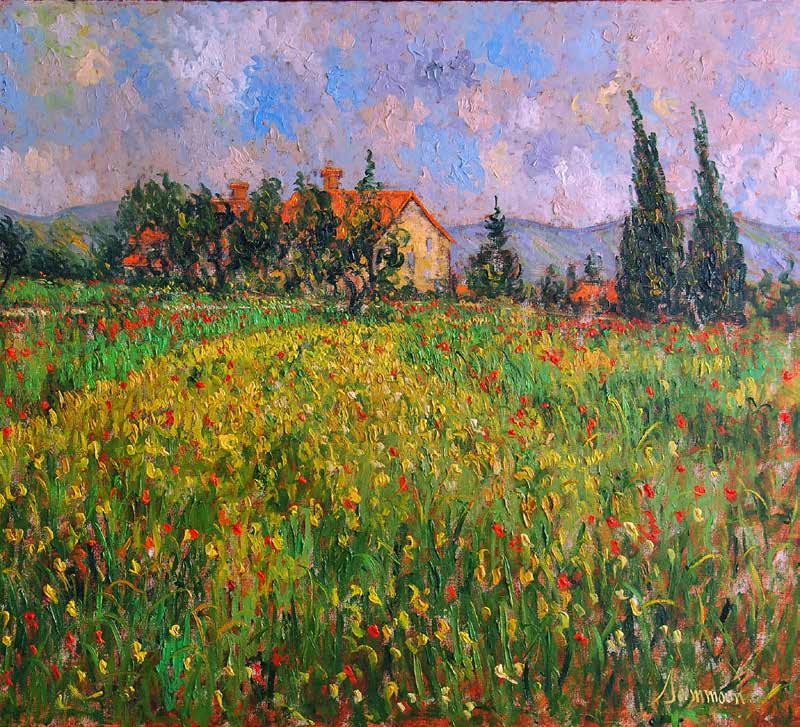
2005. As fate would have it, there was a corresponding exhibition, Samir Sammoun in the street level Gallery d’Art, an annex of the Museum adjacent to the gift and bookstore, entered via the museum’s lobby. There was quite a collection of Samir’s work on display, with a top notch reception/cocktail party filled with top notch people from the government (Quebec Prime Minister Jean Charest and his wife Michelle Dionne) and the business/ social/art segment of Montréal society. But what sealed the deal for me as far as my friend’s conviction that he was harboring the soul and spirit of Vincent in his own live body was a tour we took with the museum’s chief publicist of the major exhibition, Right Under The Sun: Landscape in Provence From Classicism to Modernism 1750-1920 which was occupying the entirety of this very special building. In this exhibition of masterpieces, van Gogh’s were the center of attention. As I was on somewhat of a press junket, I had the attention of the Director of Publicity and I invited her to view Samir’s show in the Galerie d’Art. We were both stunned and startled by not just Samir’s paintings, but by
the palpable transmission of energy by both artists via their work — it was like the cable system Samir patented, with the flow of the signal going up and down from headquarters to the last house on the hill without interruption. Of course, it will be up to future generations to place Samir in the same breath as Vincent, but next time you’re at an art fair or gallery where there is a collection of Sammouns, try this out for yourself. It was amazing how he could capture the essence of van Gogh without plagiarizing his style — a tribute indeed.
In the decade hence, Samir has begun to sculpt. He has brought to life his beloved olive tree in bronze and he plans to cast life-size versions for site-specific patches of comfort to call attention to his heart-felt desire for world peace. The United Nations would be an ideal home for such a setting, as would plazas, parks, hospitals and embassies throughout the world. The elegance and strength of the olive tree lends itself perfectly to the enduring tenacity of cast bronze. Samir’s works have contributed to many charitable causes and his vision of the sculptural park as
6 • Fine Art Magazine • Spring 2015
Farm house Tuscany with Poppies, oil on canvas, 40” x 40”
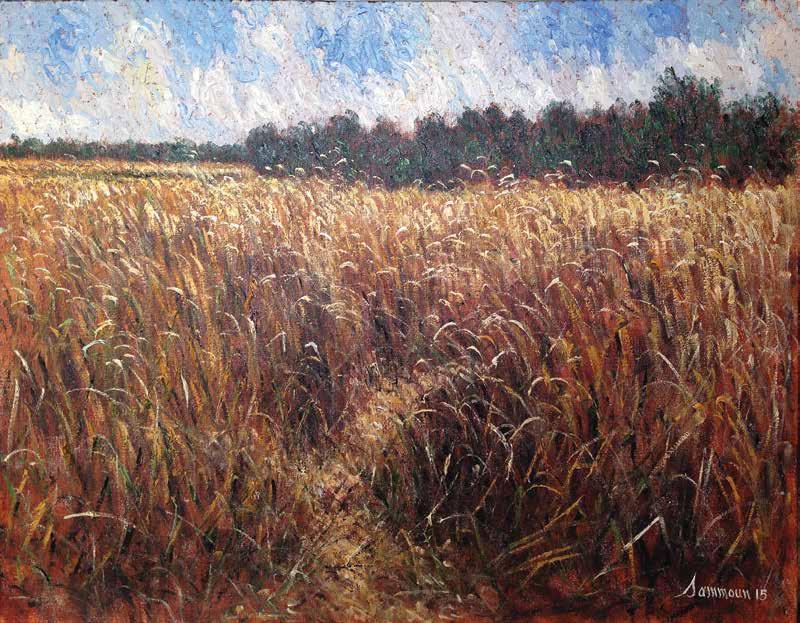
a sanctuary in the midst of chaos will not be a dream deferred if the artist has his way.
Doors open to Samir. His gifts have taken him far but it is his character that keeps him there. His is a very beckoning persona backed up by the talent and track record of a world-class artist. He is consistently happy and friendly. His roots go down deep despite what is going on around him. His humble smile and softly spoken words seemed to attract even more, as if he was and is enveloped in a golden aura. Stability and consistency are manifest in him with emotions and feelings on the surface and below that are both hidden and evident in his paintings. He is the same day in and day out, extremely talented, kind and generous — you are always going to know what this man is going to be like. We live in an imperfect world with imperfect people and there are going to be disappointments.
Sammoun’s art seems to say that while this may be true, there is the possibility of perfection, not just in a landscape or a portrait, but in a way of life. Of quietude, serenity. There is a special magic, an intricate depth inherent in Samir Sammoun’s work that results in a spectacle, a spectacular portrayal of splendor that brings to mind these words of the master art critic of the ages:
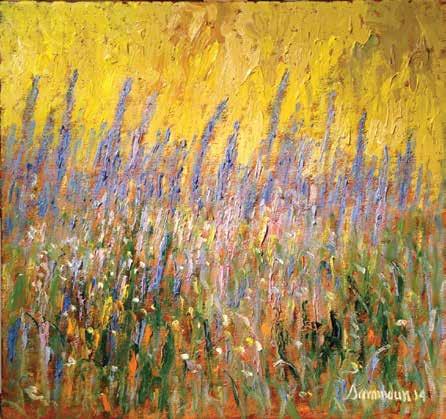 Wheat Field, oil on canvas, 48” x 60”
Wheat Field, oil on canvas, 48” x 60”
Fine Art Magazine • Spring 2015 • 7
Lavande et soleil, Oil on canvas, 24” x 24”
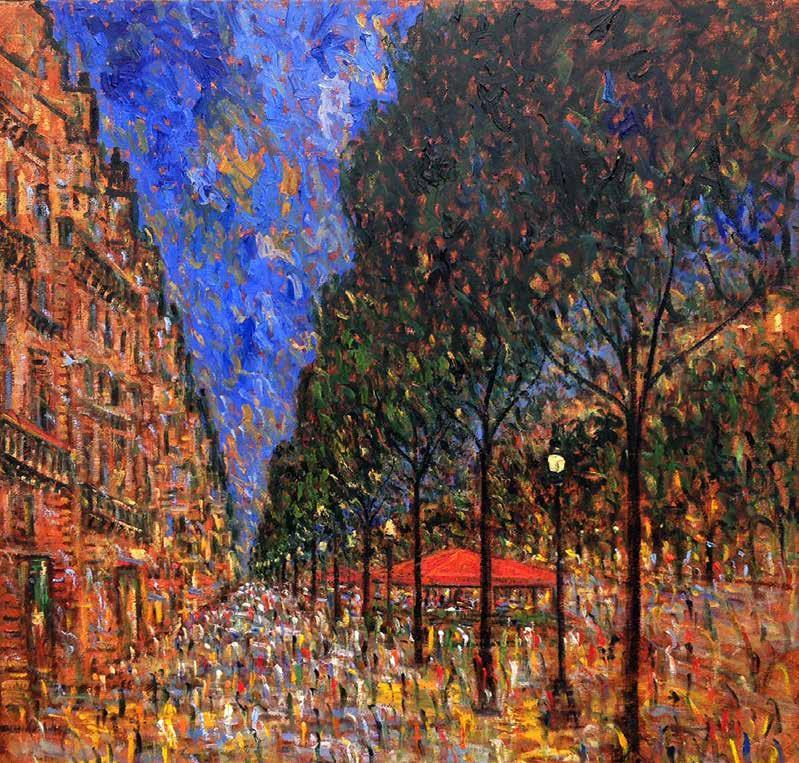
“Consider the lilies of the field, how they grow: they toil not, they spin not; and yet I say unto you, that Solomon in all his glory was not arrayed like one of these.” (Luke 12:27). Sammoun gets this. His landscapes and flowers contain an energy and brilliance, conveyed as only a self-realized artist can. Soft, serene and delicate, they hold a mesmerizing power over a viewer. Whether a wheat field or a mountain range, they are elegantly composed, carefully colored, fully conceived inviting yet somewhat foreboding in their awesomeness. These paintings are done by a man who goes way beyond the surface. He sees things and he sees into things, every blade of grass, as Dylan said, “Every grain of sand.” This collection quietly states there’s a large life in front of you, a life grounded in imparting the truth and beauty of nature in its purest form, unadulterated, recognizable, perfect. These paintings — dynamic combinations of contentment and wonder — are treasures, works of great beauty. Masterpieces of love.
e-mail: samirsammoun@gmail.com
450-672-8705
www.samirsammoun.com •
•
s
8 • Fine Art Magazine • Spring 2015
An Evening in Paris, oil on canvas, 47” x 47”

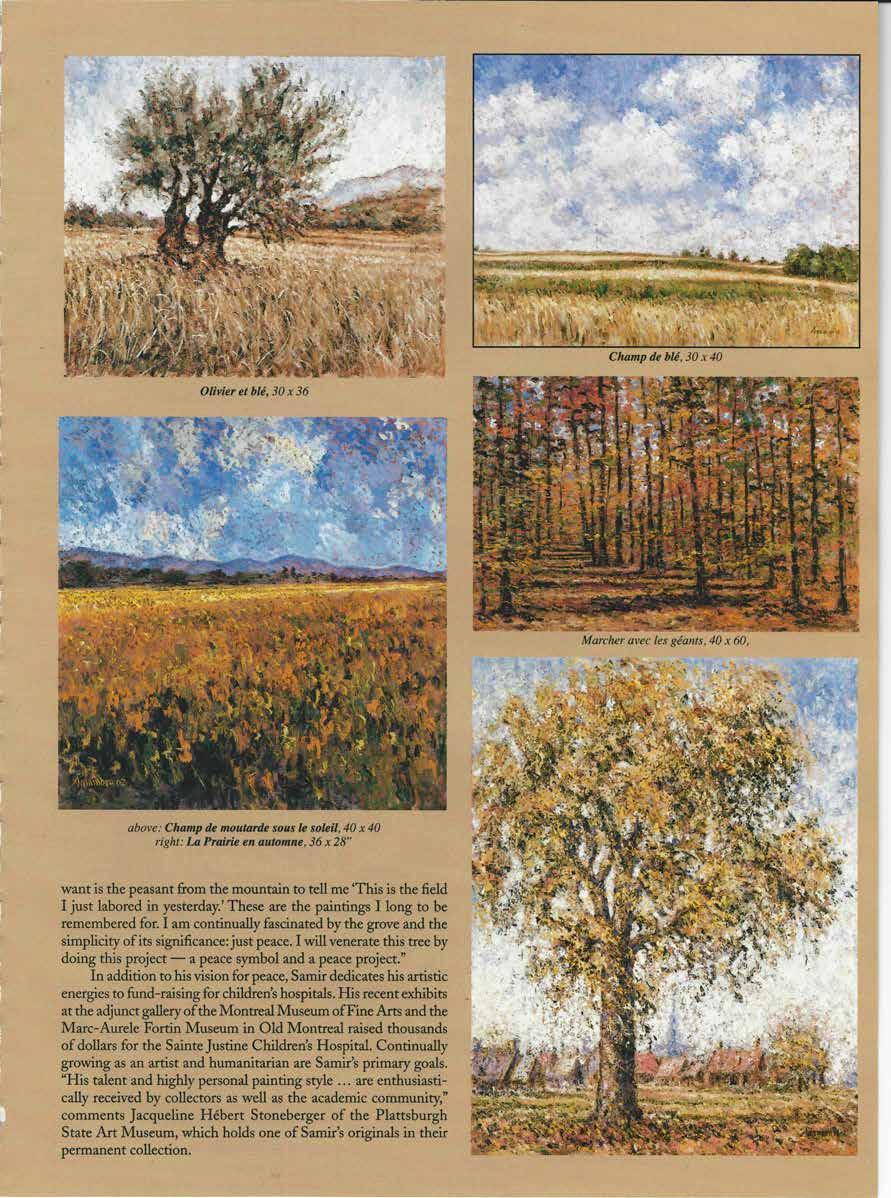


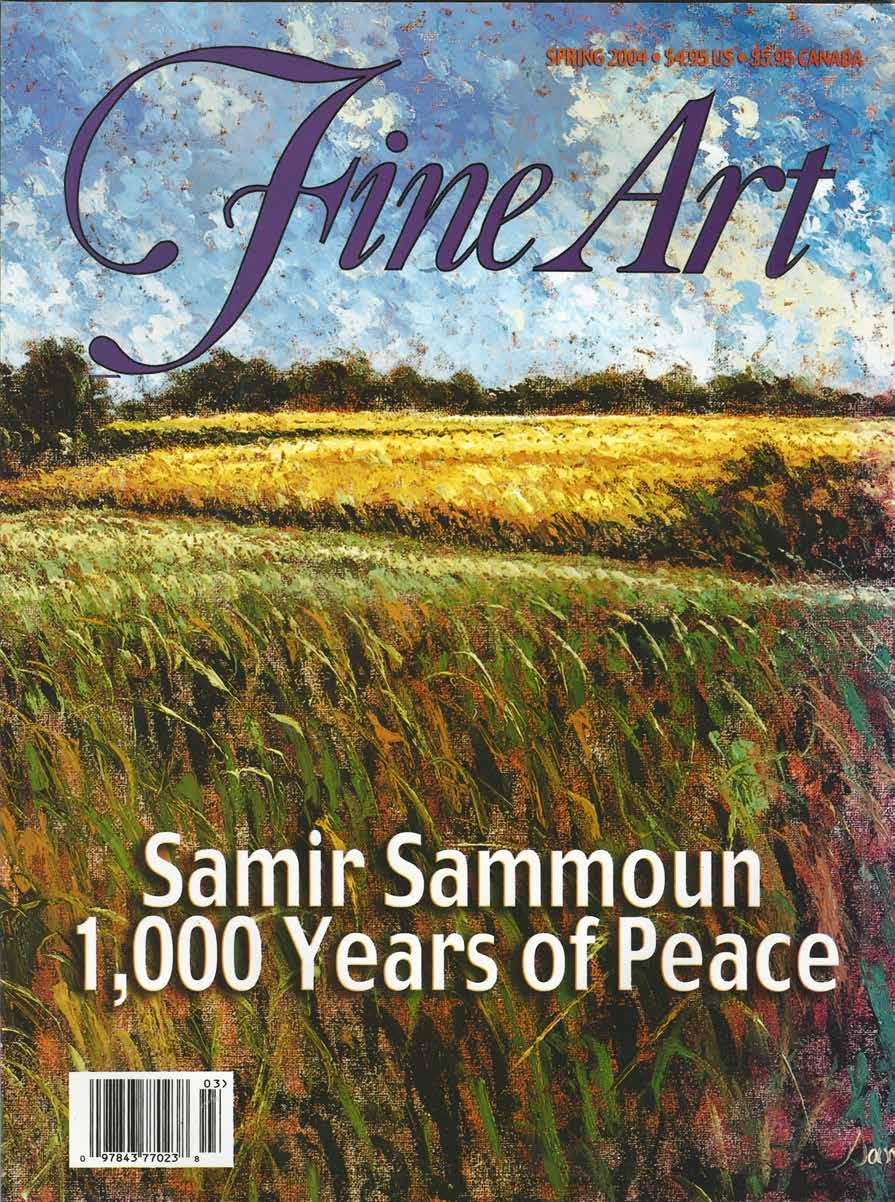



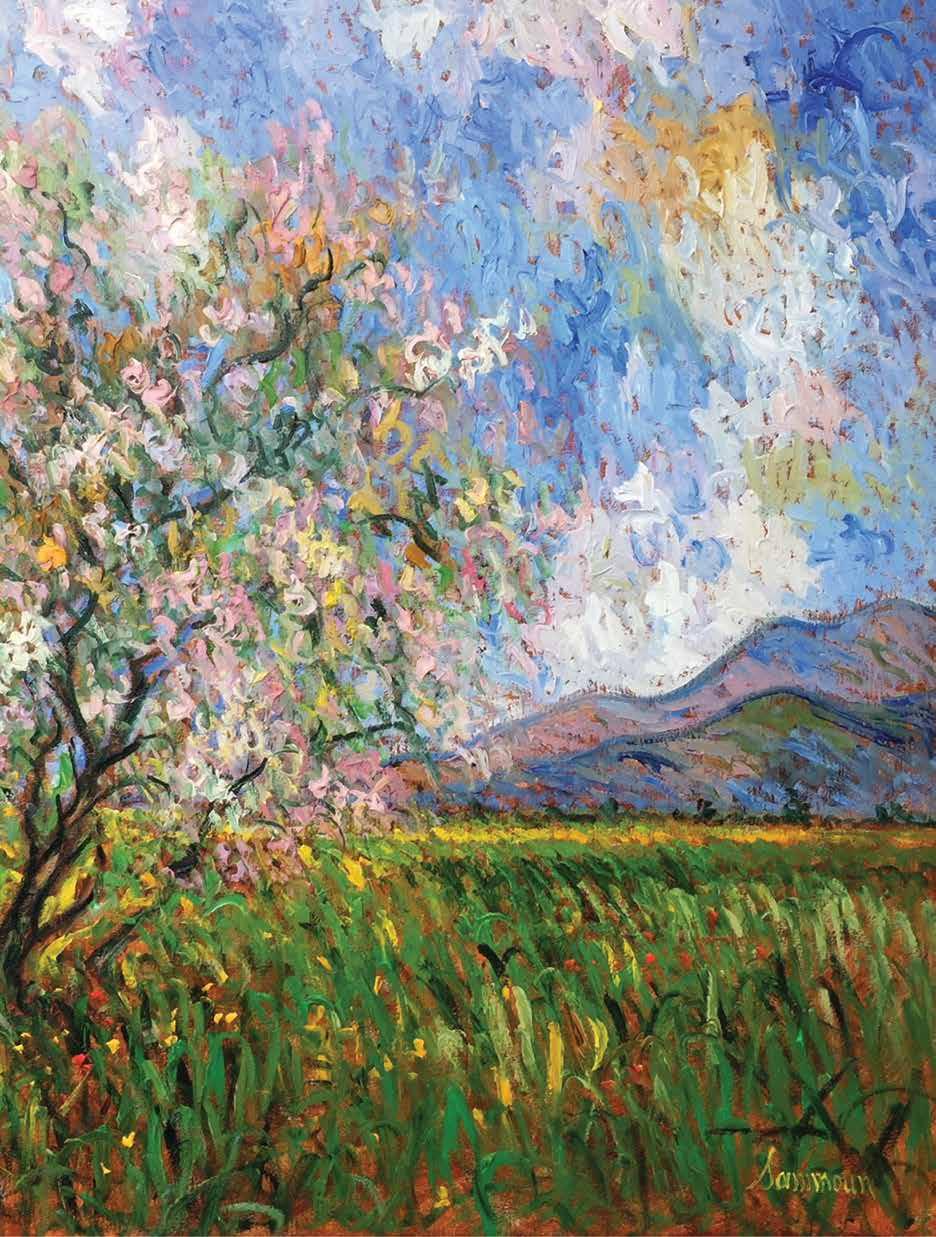

“ALMOND TREE IN BLOOM,” PAGE 30 SPRING 2018 • $10US
Samir
Sammoun Celebrates Spring


Timeless and Alluring The Landscapes of Samir Sammoun
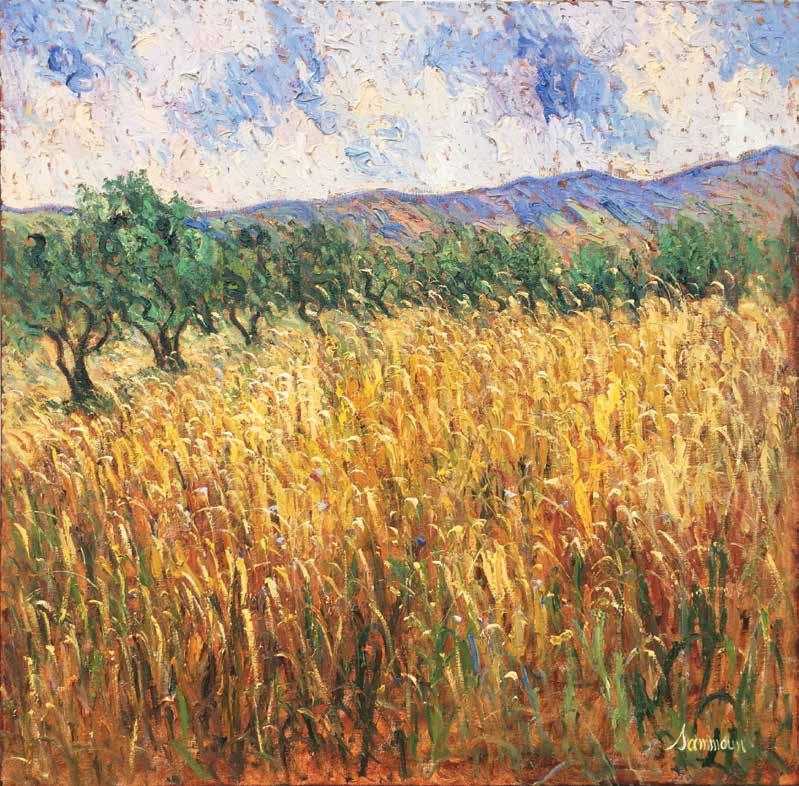 By VICTOR FORBES
By VICTOR FORBES
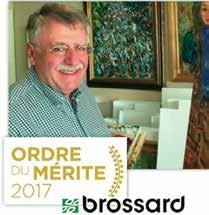
SWheat Field And Young Olive Grove, Oil On Canvas, 48” x 48”
AMIR SAMMOUN is world-renowned for his inspired Post-Impressionist renditions of lush, lavender wheat fields; cedar trees, olive groves and mountain ranges of his boyhood home in Lebanon; snowy streets of his adopted home, Montréal, quaint yet bustling; orchards, fields of blooming flowers, forests and sunsets over beaches…Sammoun’s brilliance is unparalleled in capturing the atmospheric and fleeting colors of our ever-changing world. His innovative approach and celebrated compositions make him one of the most acclaimed landscape painters working in North America today. Sammoun’s richly layered impastos exquisitely blend the post-Impressionistic style with spontaneous, gestural brushwork. Initiating each canvas as did the Dutch Masters, he applies a rich, burnt-sienna with brush and rag, accentuating the grain of his surface and providing luminous inner light underneath his brilliant and richly colored palette. Sammoun continues to attract the attention of international scholars and museums including the Montreal Museum of Fine Art, the Marc-Aurele Fortin Museum and Boston’s Museum of Fine Arts.” He is one of the “headliners” at Artexpo where he has been a top-selling artist for many years.
Page 30 • SunStorm/Fine Art • Spring 2018
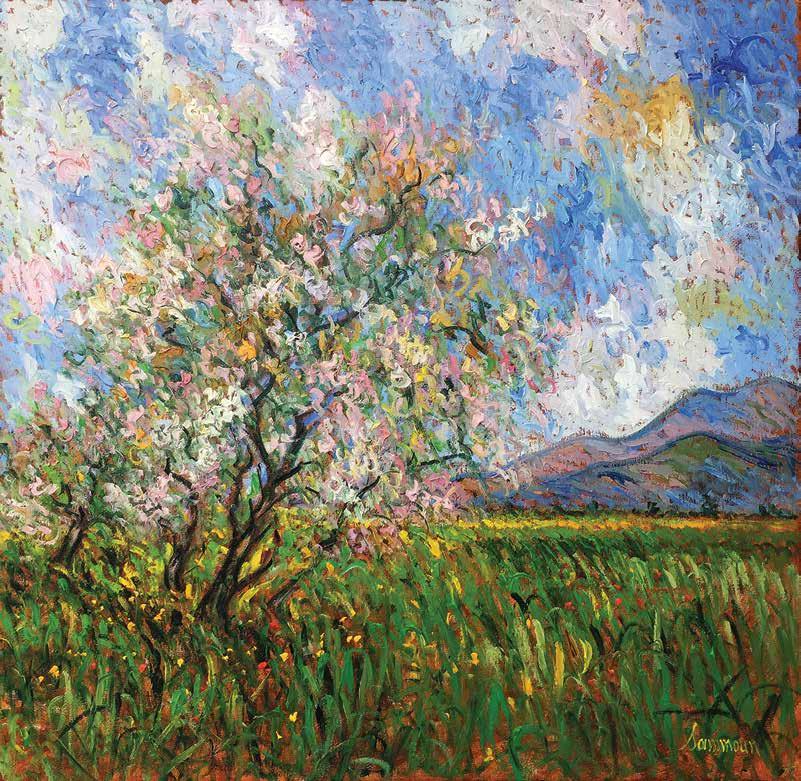
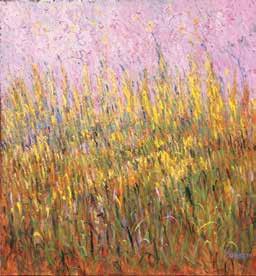
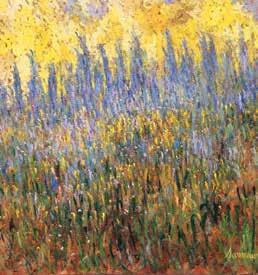
 Lavande et Soleil, Oil on canvas, 48” x 48”
Central Park, View On West Side, Oil on canvas, 36” x 36”
Amandier en Fleurs, Oil on canvas, 48” x 48”
Lavande et Soleil, Oil on canvas, 48” x 48”
Central Park, View On West Side, Oil on canvas, 36” x 36”
Amandier en Fleurs, Oil on canvas, 48” x 48”
SunStorm/Fine Art • Spring 2018 • Page 31
The Ballet II, Oil on canvas, 48” x 48”
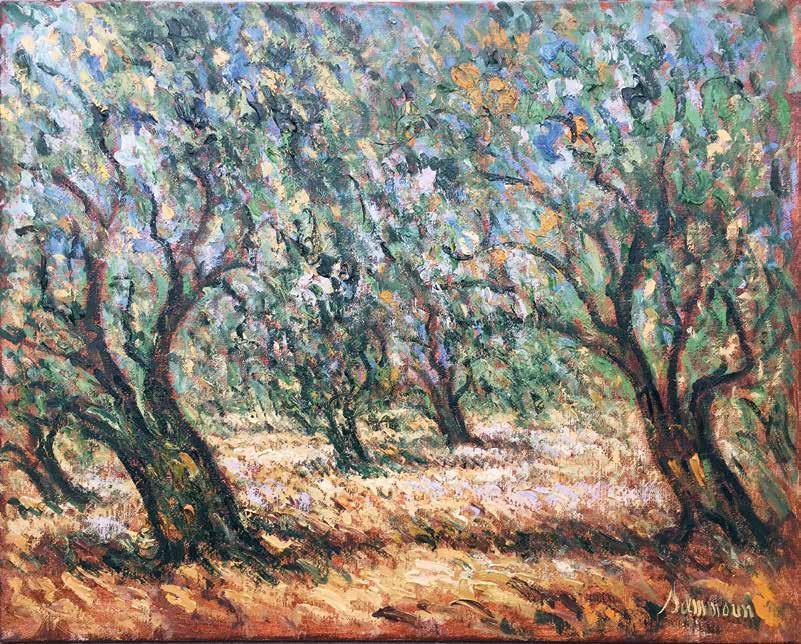

Sammoun was awarded the prestigious Order of Merit by the City of Brossard in 2017, an honor reserved for residents who demonstrate an exceptional commitment to the community. Sammoun is a long-time resident of Brossard, located on the south shore of Montreal, and was recognized for his remarkable contributions to the arts and
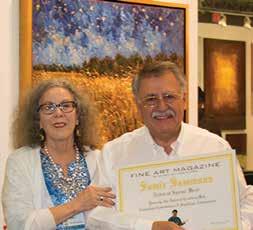

cultural life of his beloved city.
“Sammoun has indeed built upon history to develop a personal style that is reflective of his inner being. Nothing is held back by these emotionally charged canvases that capture the essence of Nature as recreated by Man, in this instance Samir Sammoun,” writes Constance Schwartz, Director and Curator Nassau County Museum of Art, Roslyn Harbor,
Brossard is proud to honor outstanding citizens at the Order
Merit
ceremony. This prestigious event, organized by the City, was held in February 2017, during which medals of honor were presented to the winners for their exceptional commitment to the community in the following areas: Science, Education, Culture, Community, Sport, Humanitarian, Economy and the Environment
SunStorm/Fine Art Magazine publisher Jamie Ellin Forbes bestowed the publications’ “Artist of Special Merit” award to Sammoun at Artexpo 2016
Samir with Sallie Hirshberg and her Galerie d’Orsay staff
Samir Sammoun, recipient of the Order of Merit of Brossard 2017, pictured with the Mayor of Brossard and Mr. Daniel Lucier, adviser. Year after year,
of
award
Page 32 • SunStorm/Fine Art • Spring 2018
Olive Grove Before Harvest, Oil on canvas, 24” x 30”

New York in the introduction to Sammoun’s monograph, Walking With Giants – a paean to the artist’s dedication to the traditions and impact of those who came before him, notably van Gogh.
“Sammoun’s body of work is an indepth depiction of the connections he makes between his long-time residence in Montréal and birth and childhood in Lebanon. Painting and sculpture emerge as statements of common familiarity to be shared by all. His admirers enter into a personal involvement with the work making him a man for all seasons of expression through the universal language of art,” stated Jamie Ellin Forbes, Director of the Fine Art Museum of Long Island (1990-1995) and publisher of Fine Art Magazine in bestowing the magazine’s “Artist of Special Merit” award to Samir at Artexpo in 2016. “Honoring the spirit of creativity with exceptional contributions and significant achievement, Sammoun has taken his role as an artist to an exceptionally high level, not only for his paintings but for his interests in the human condition and what he can do to foster a more peaceful environment for all.”
Samir Sammoun’s originality and unique style have caught the attention of viewers, collectors and art lovers worldwide. When he first showed his work at Artexpo in New York in 1996, the reaction was immediate and positive. What was said about him then still holds true today: “The fresh colorful Impressionistic renditions presented in his artwork have been received with unprecedented enthusiasm... Samir is a fresh and exciting talent depicting the landscapes he sees in rich colors with his own wonderfully unique impressionistic style,” commented Robert L. Mooney, Director of the Galleries J.R. Mooney, San Antonio, Texas. www.samirsammoun.com
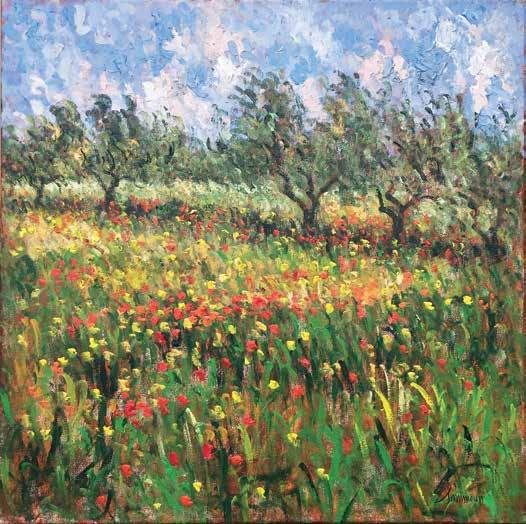
 Parade, Oil on canvas, 48” x 36”
Spring, Tuscany, Oil on canvas, 36” x 36”
Parade, Oil on canvas, 48” x 36”
Spring, Tuscany, Oil on canvas, 36” x 36”
SunStorm/Fine Art • Spring 2018 • Page 33
Cherry Blossom, Central Park, Oil on canvas, 36” x 36”
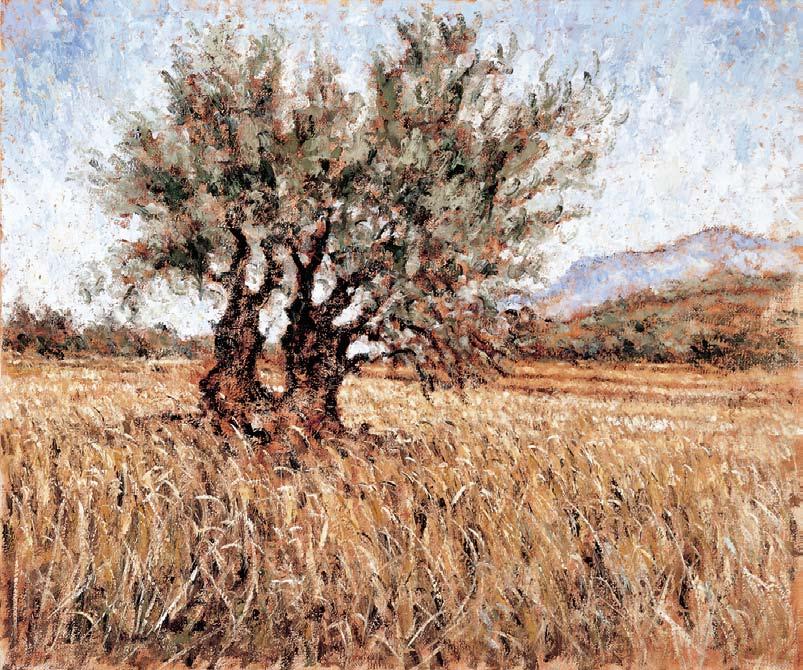
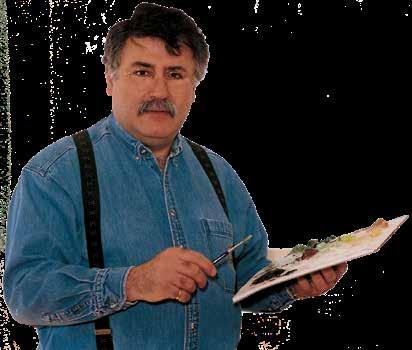
The trees went forth on a time to anoint a king over them; and they said unto the olive tree, Reign thou over us.
The trees went forth on a time to anoint a king over them; and they said unto the olive tree, Reign thou over us.
But the olive tree said unto them, Should I leave my fatness, wherewith by me they honour God and man, and go to be promoted over the trees?
But the olive tree said unto them, Should I leave my fatness, wherewith by me they honour God and man, and go to be promoted over the trees?
Judges 9:8-9 s
Judges 9:8-9 s
1
1
PUBLISHED BY & © SUNSTORM ARTS PUBLISHING CO., POB 481 KEENE VALLEY, NY
12943
victor@fineartmagazine.com
518-593-6470 •















































 Ticonderoga, July 30, 1609, 8 am Before the Battle, 2009, oil on canvas, 40” x 60”
Isle La Motte, 2009, oil on canvas, 40” x 48”
Ticonderoga, July 30, 1609, 8 am Before the Battle, 2009, oil on canvas, 40” x 60”
Isle La Motte, 2009, oil on canvas, 40” x 48”

 Ticonderoga, July 30, 1609, Midnight After the Battle, 2009, oil on canvas, 40” x 60”
Ticonderoga, July 30, 1609, Midnight After the Battle, 2009, oil on canvas, 40” x 60”






 Olivier, oil on canvas, 48” x 60”
Olivier, oil on canvas, 48” x 60”







 Wheat Field, oil on canvas, 48” x 60”
Wheat Field, oil on canvas, 48” x 60”











 By VICTOR FORBES
By VICTOR FORBES




 Lavande et Soleil, Oil on canvas, 48” x 48”
Central Park, View On West Side, Oil on canvas, 36” x 36”
Amandier en Fleurs, Oil on canvas, 48” x 48”
Lavande et Soleil, Oil on canvas, 48” x 48”
Central Park, View On West Side, Oil on canvas, 36” x 36”
Amandier en Fleurs, Oil on canvas, 48” x 48”






 Parade, Oil on canvas, 48” x 36”
Spring, Tuscany, Oil on canvas, 36” x 36”
Parade, Oil on canvas, 48” x 36”
Spring, Tuscany, Oil on canvas, 36” x 36”

